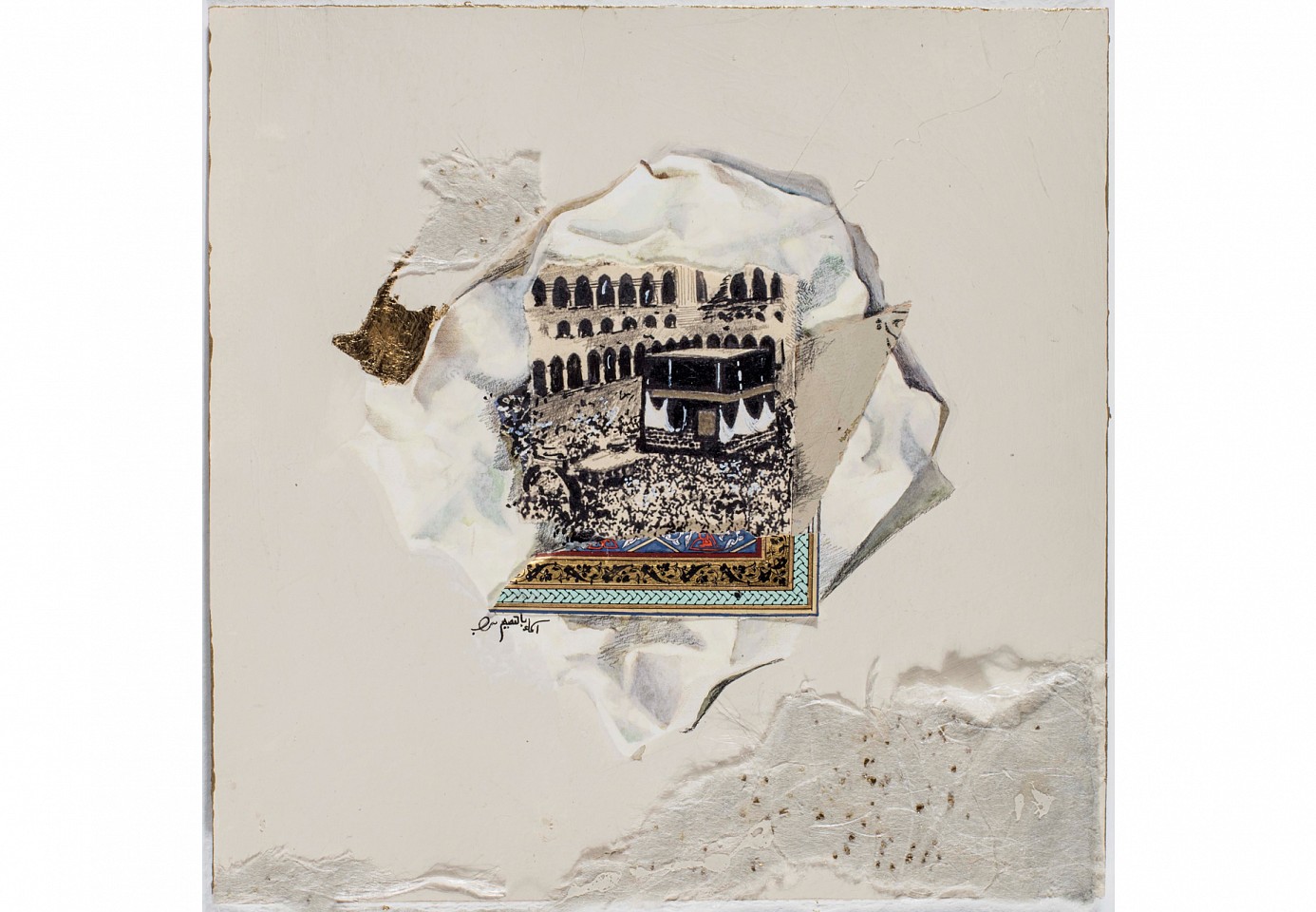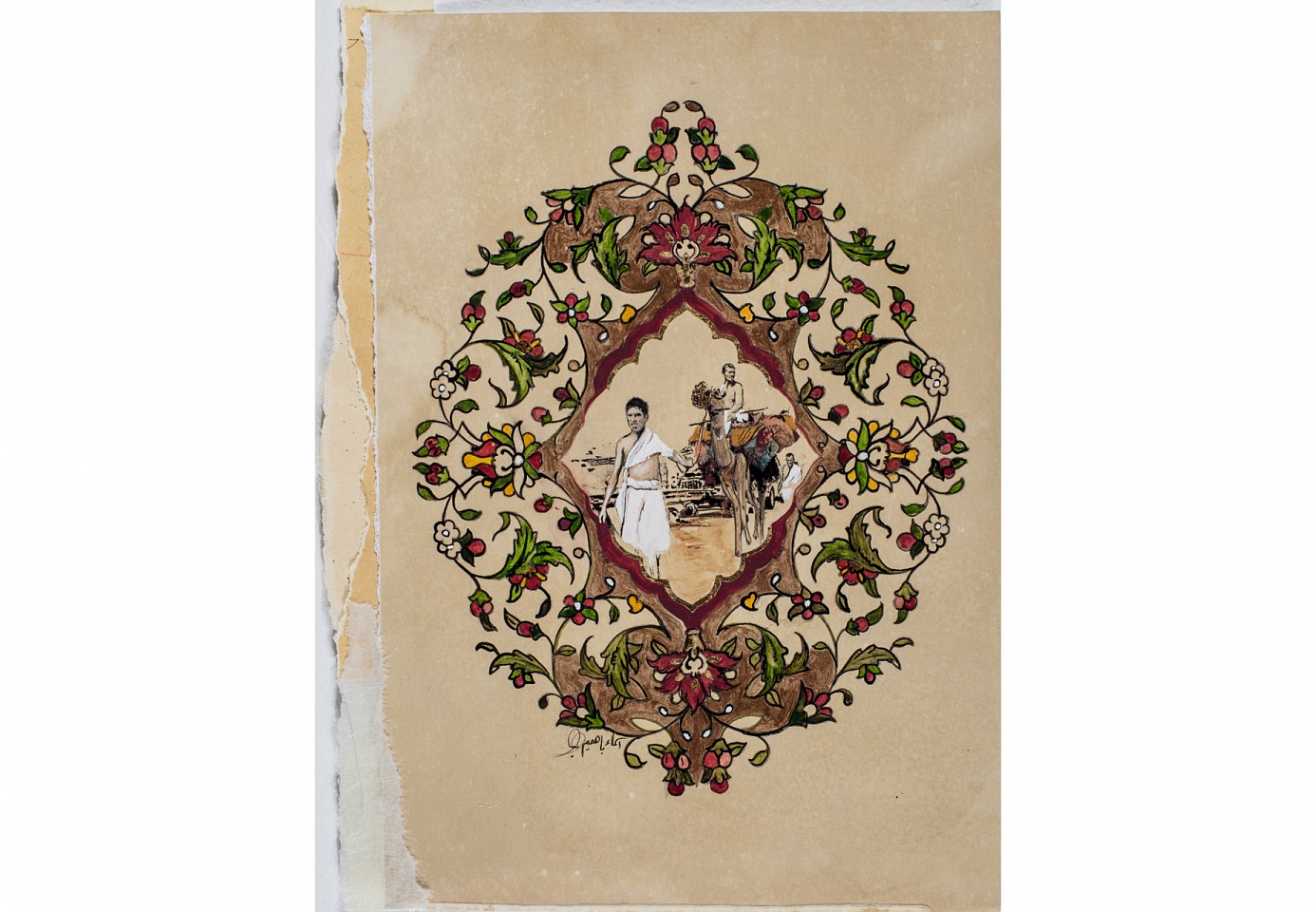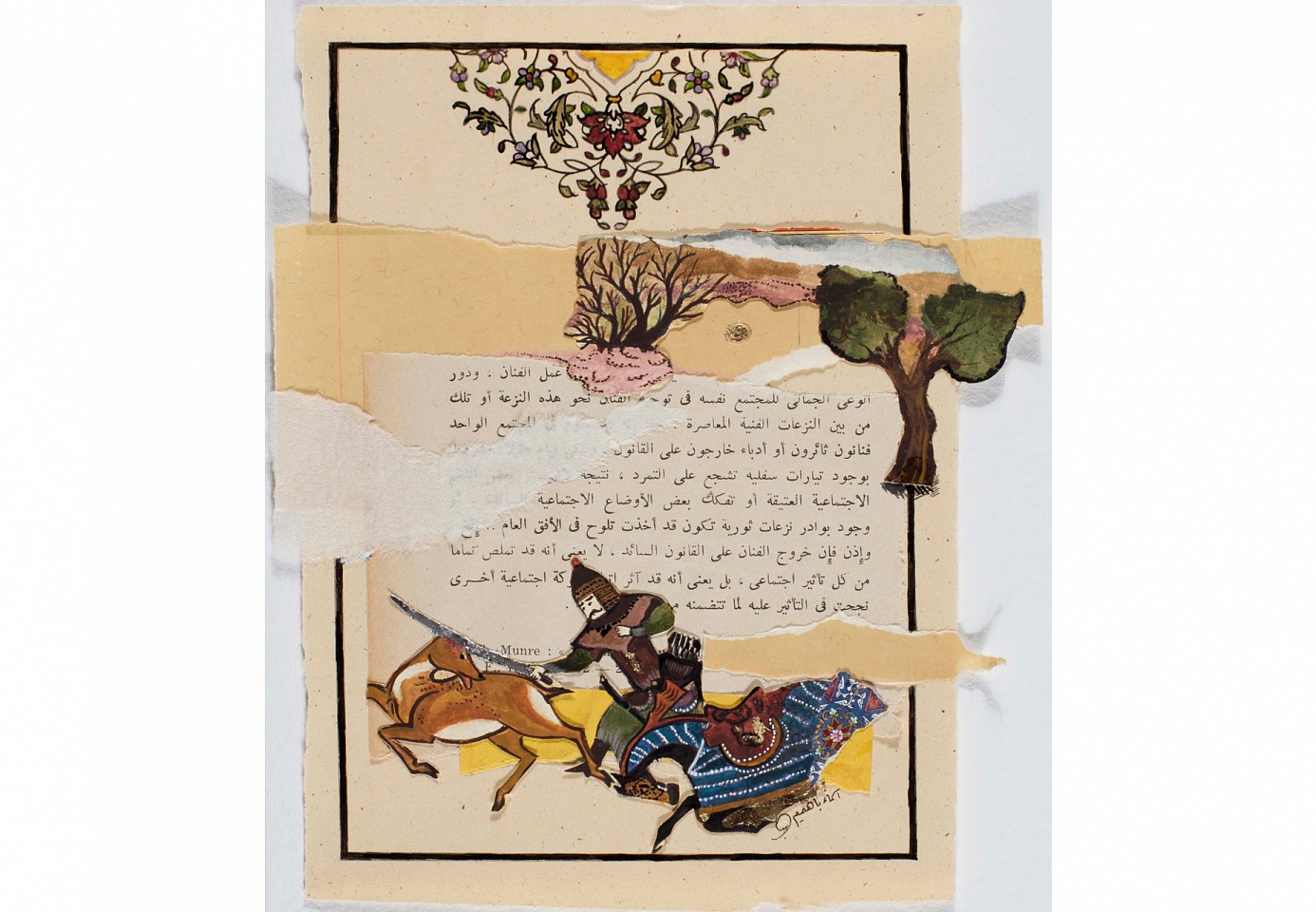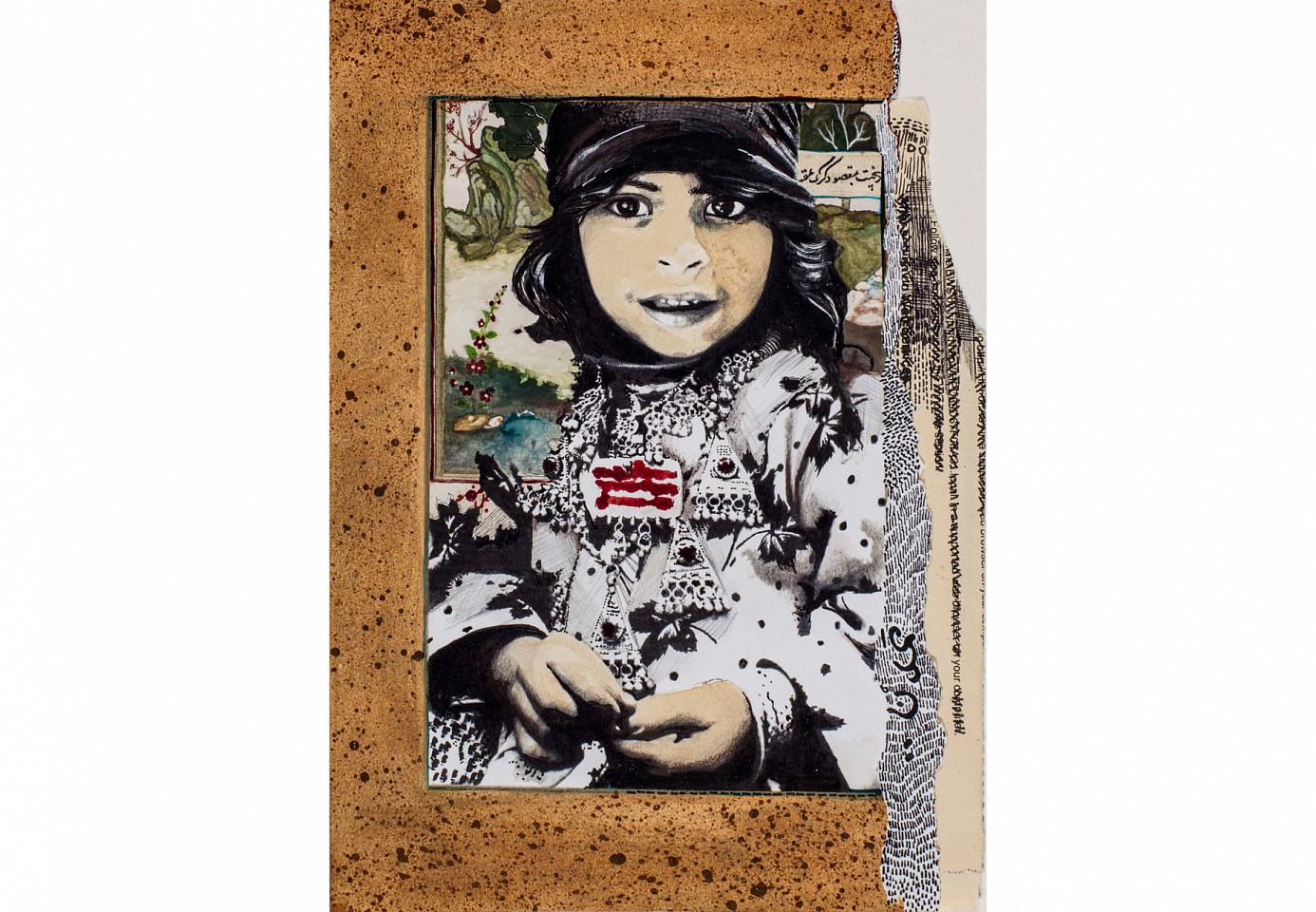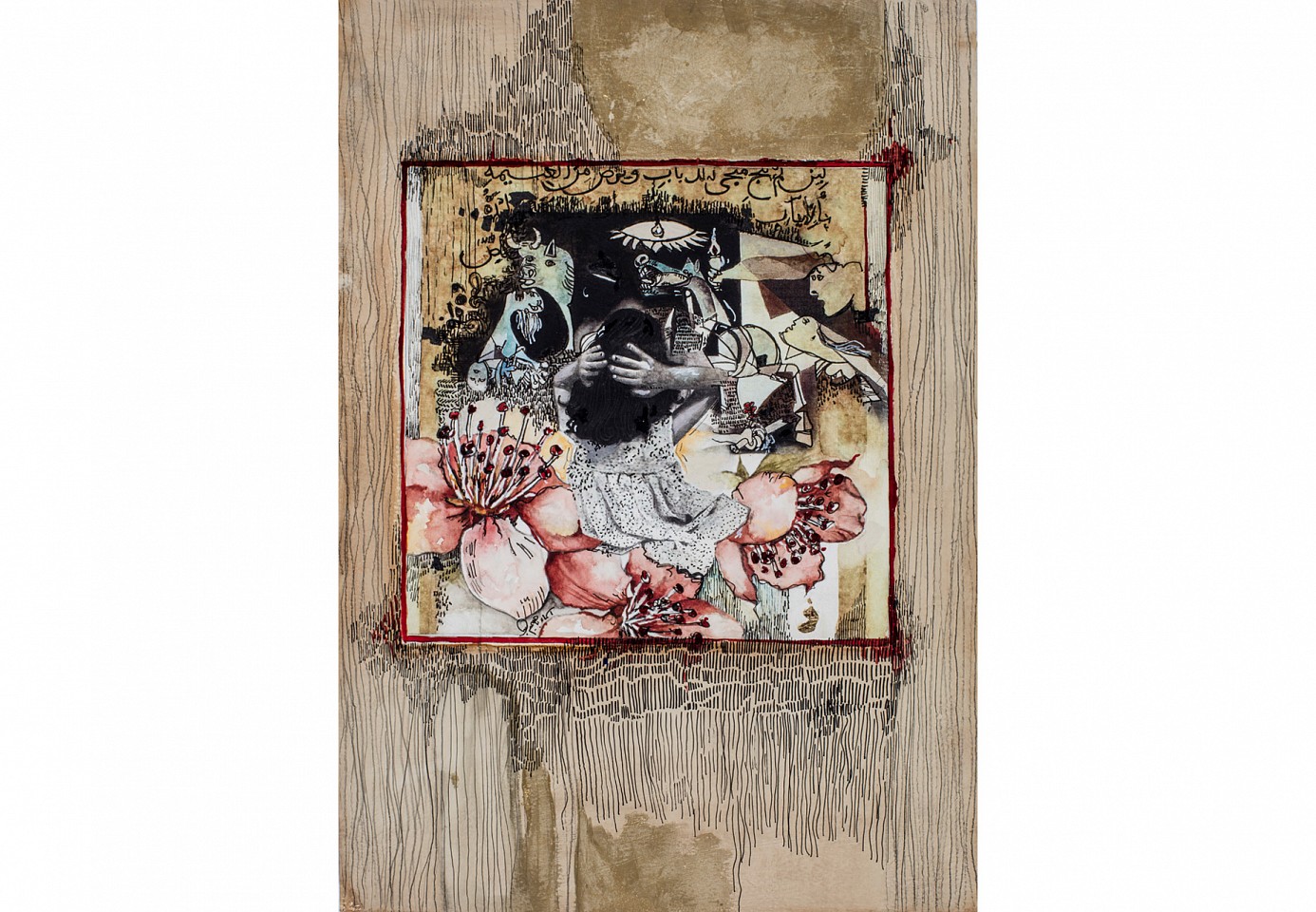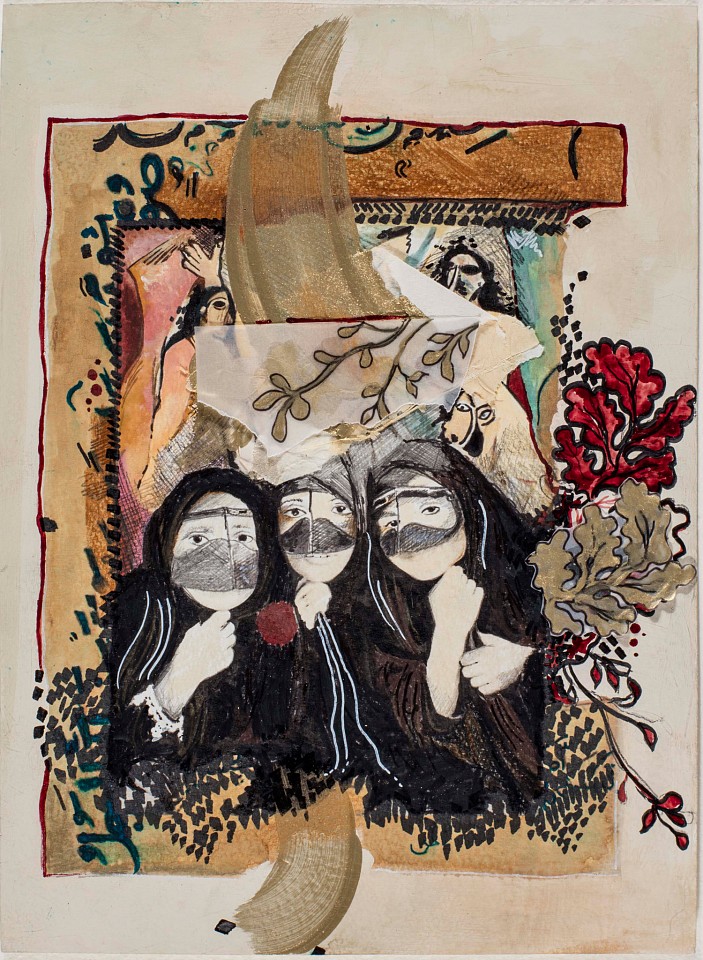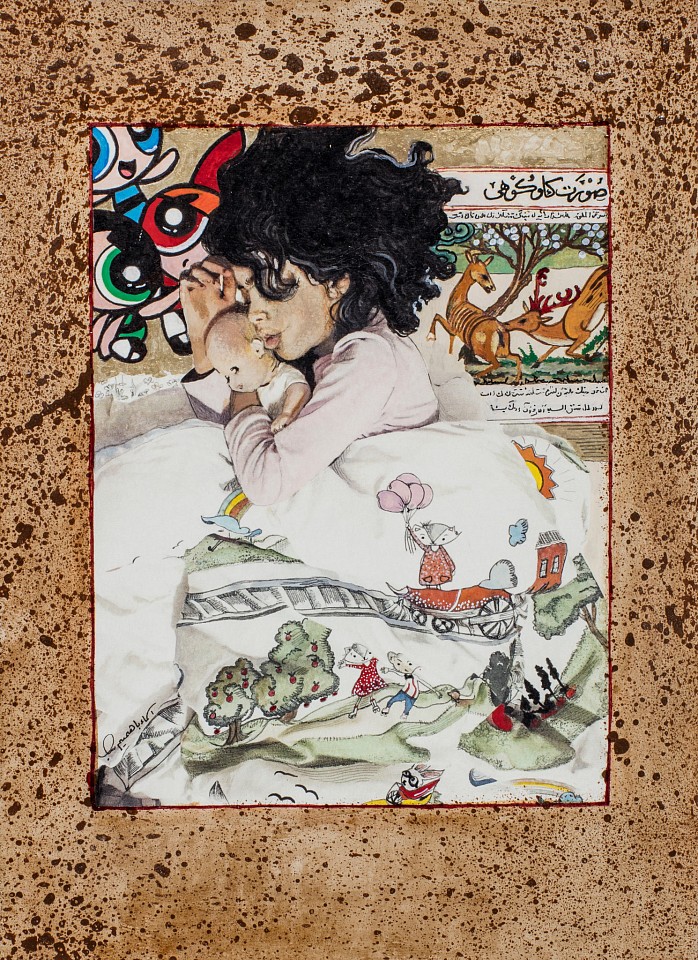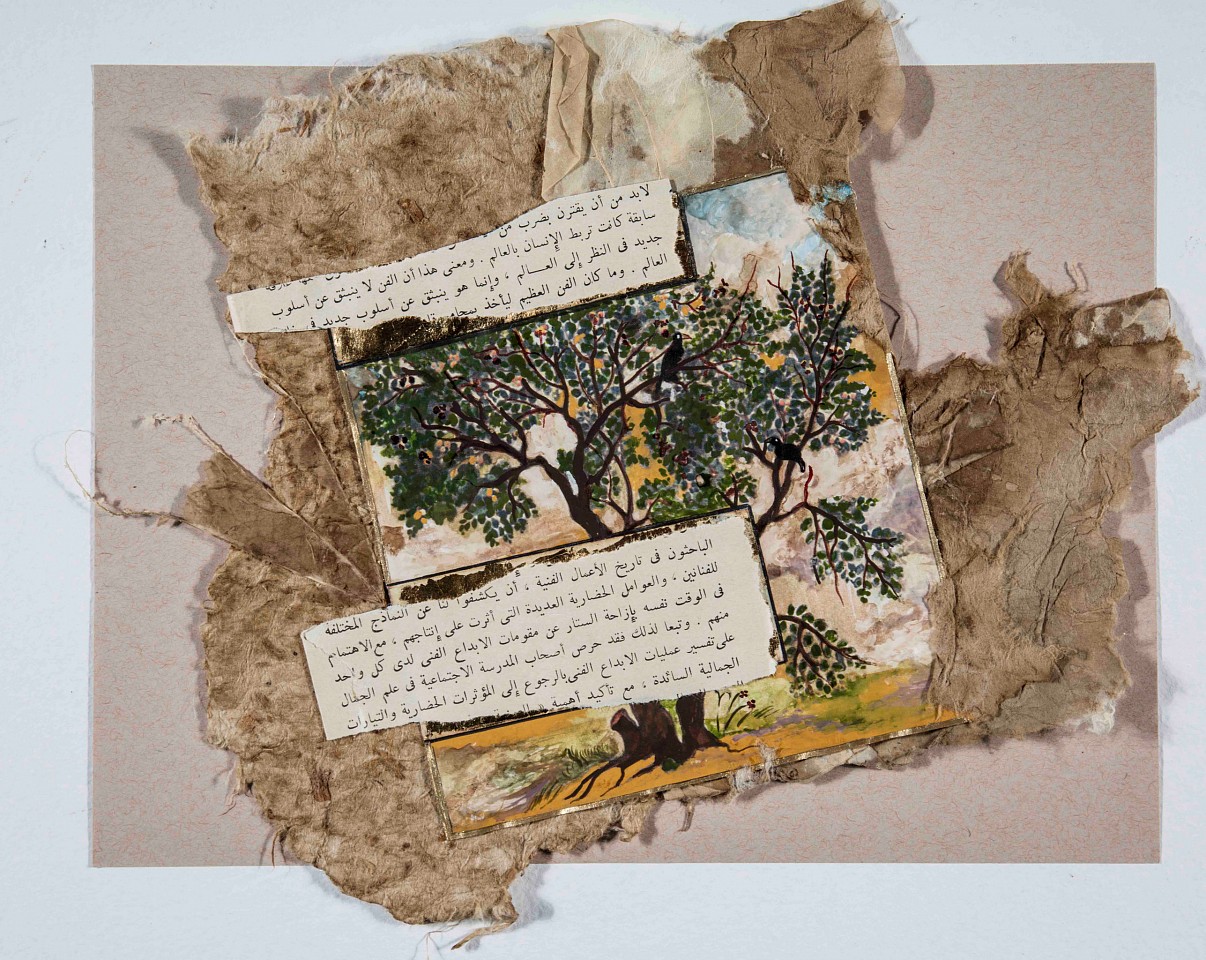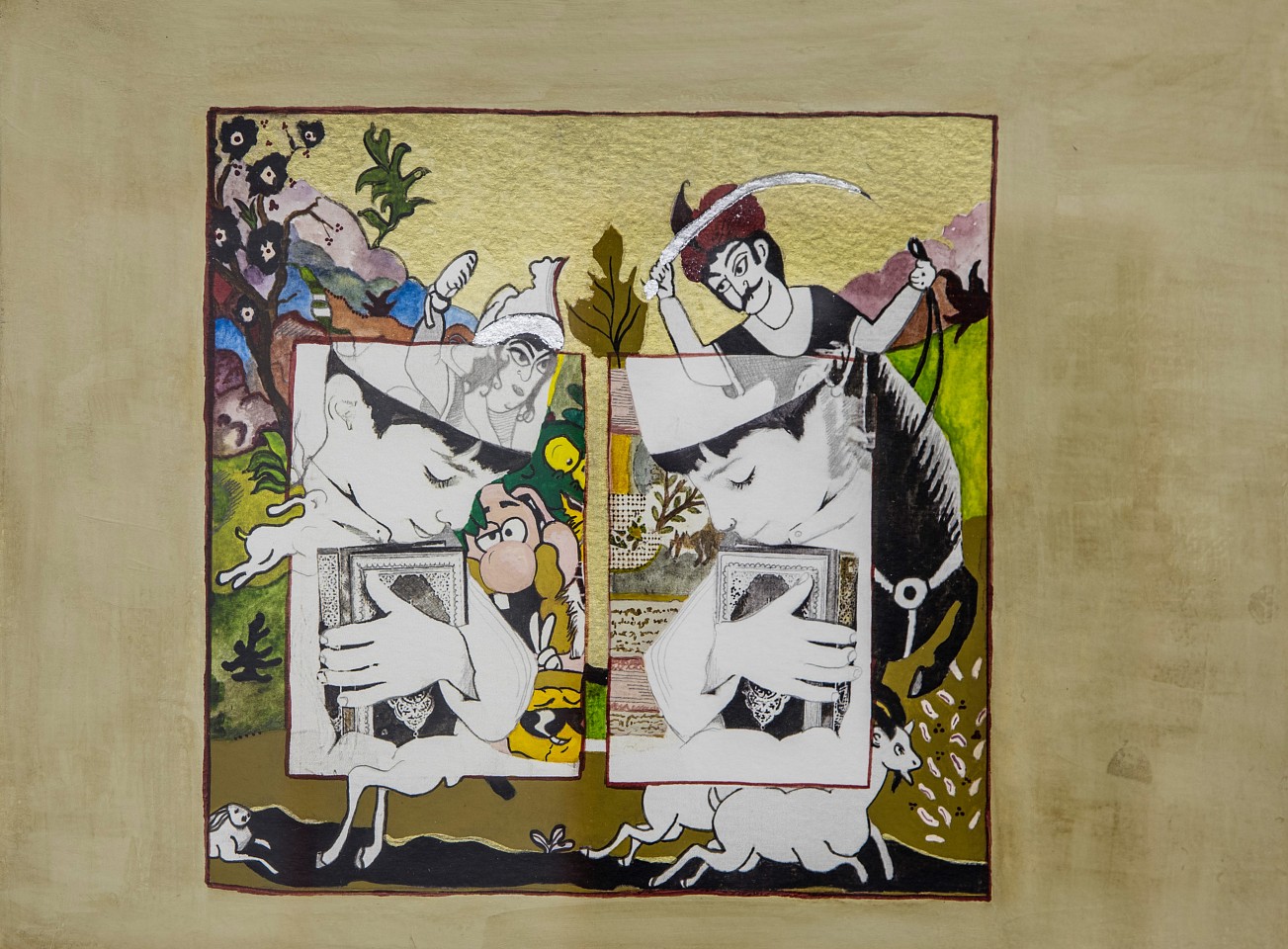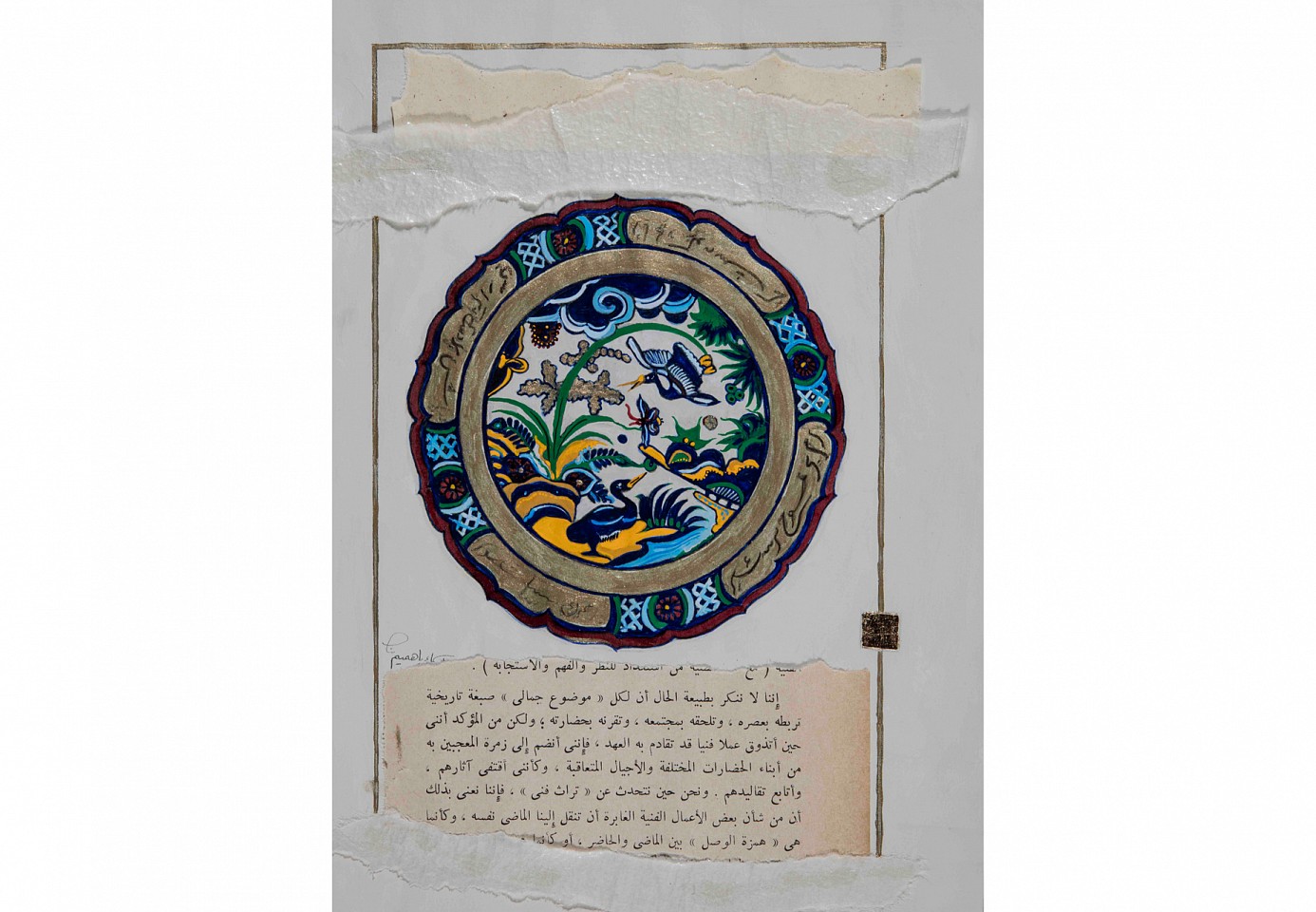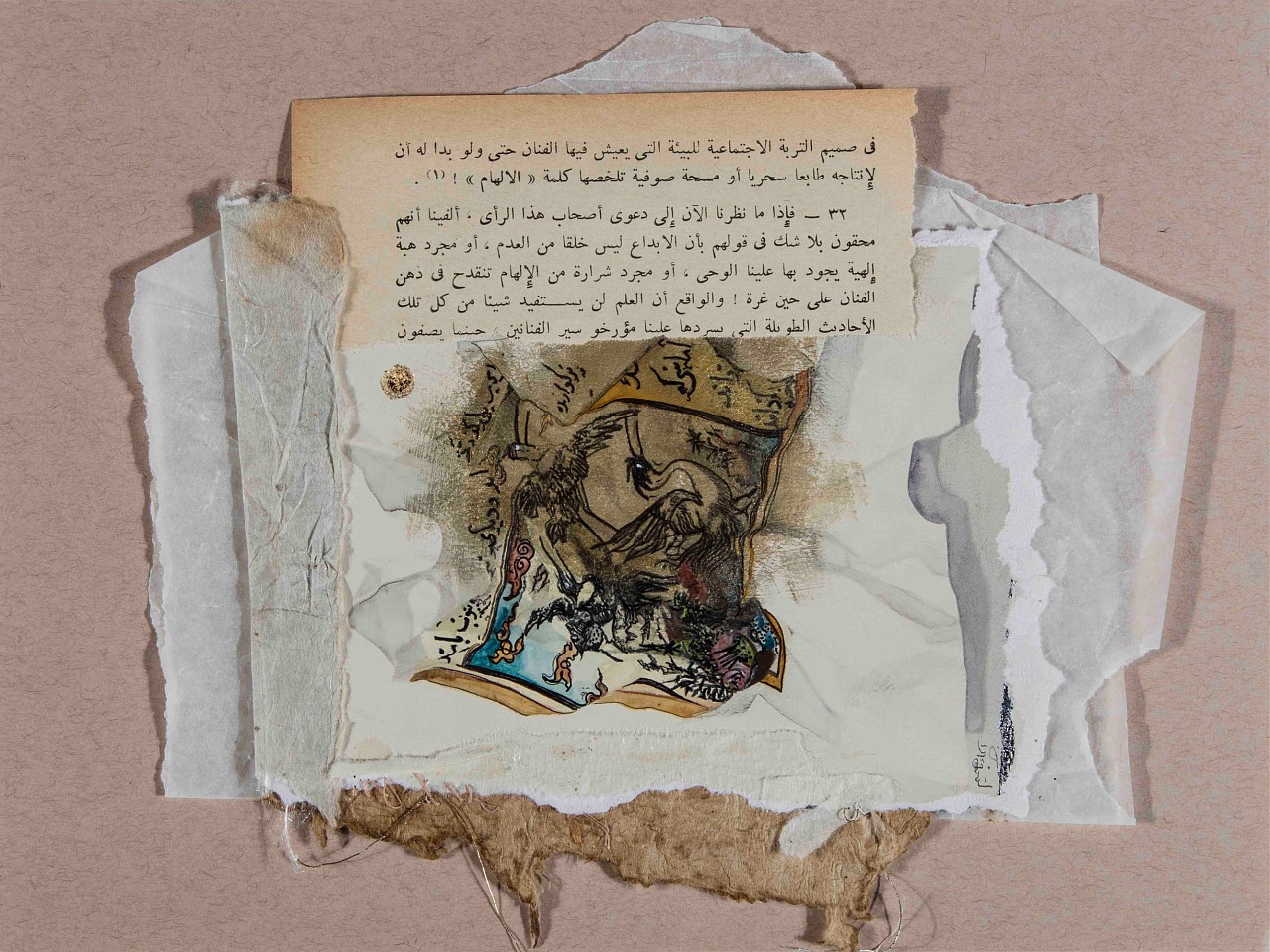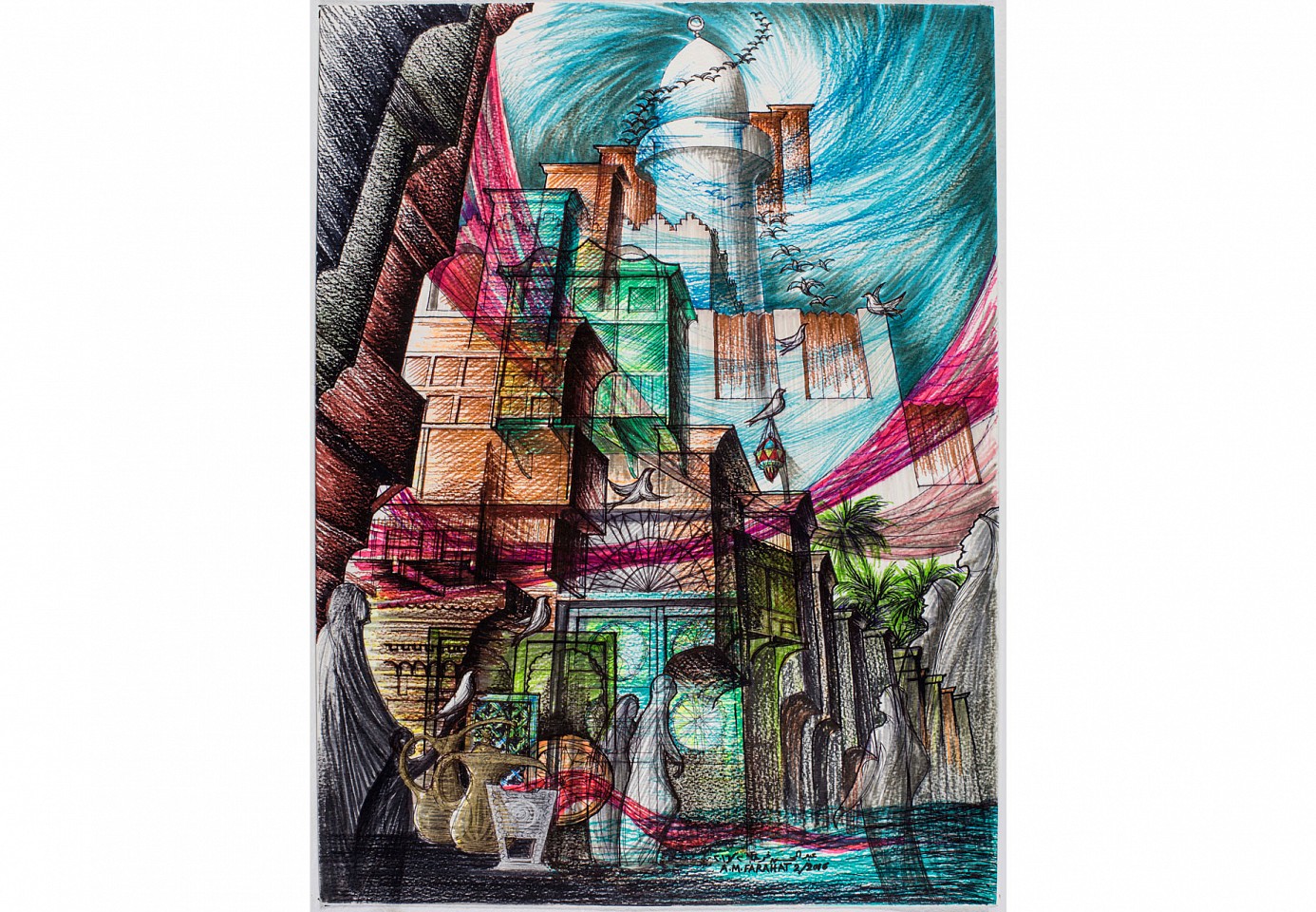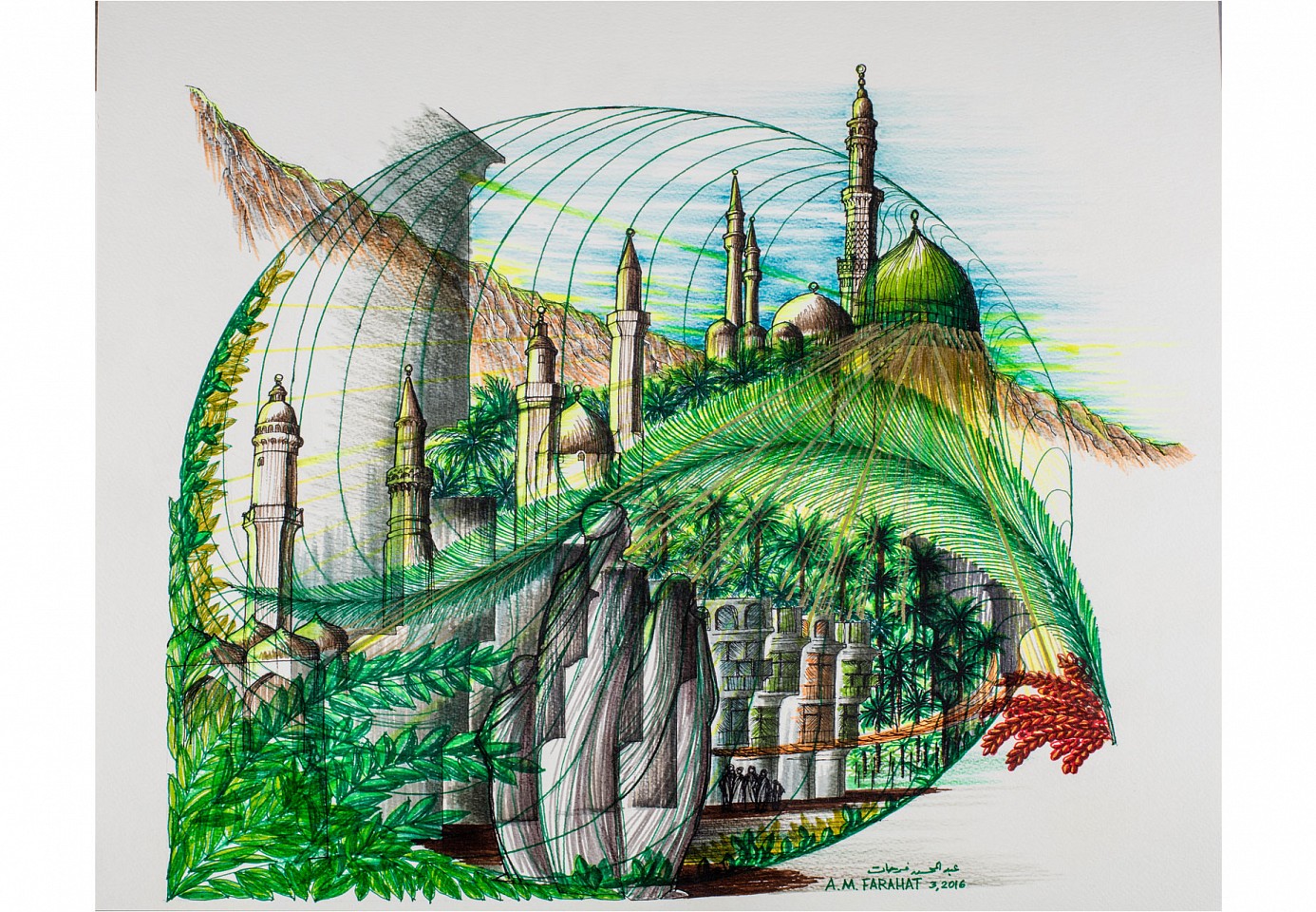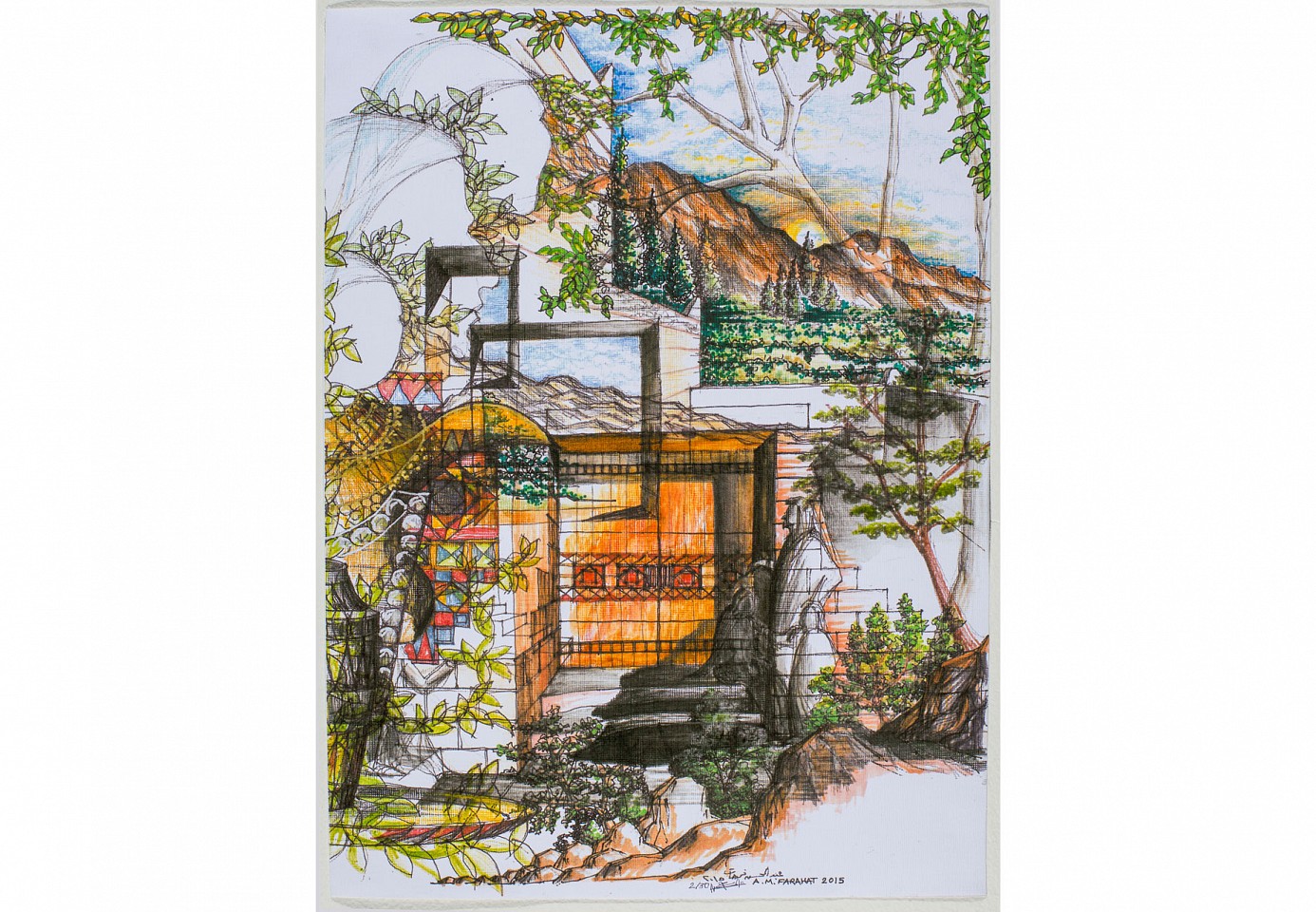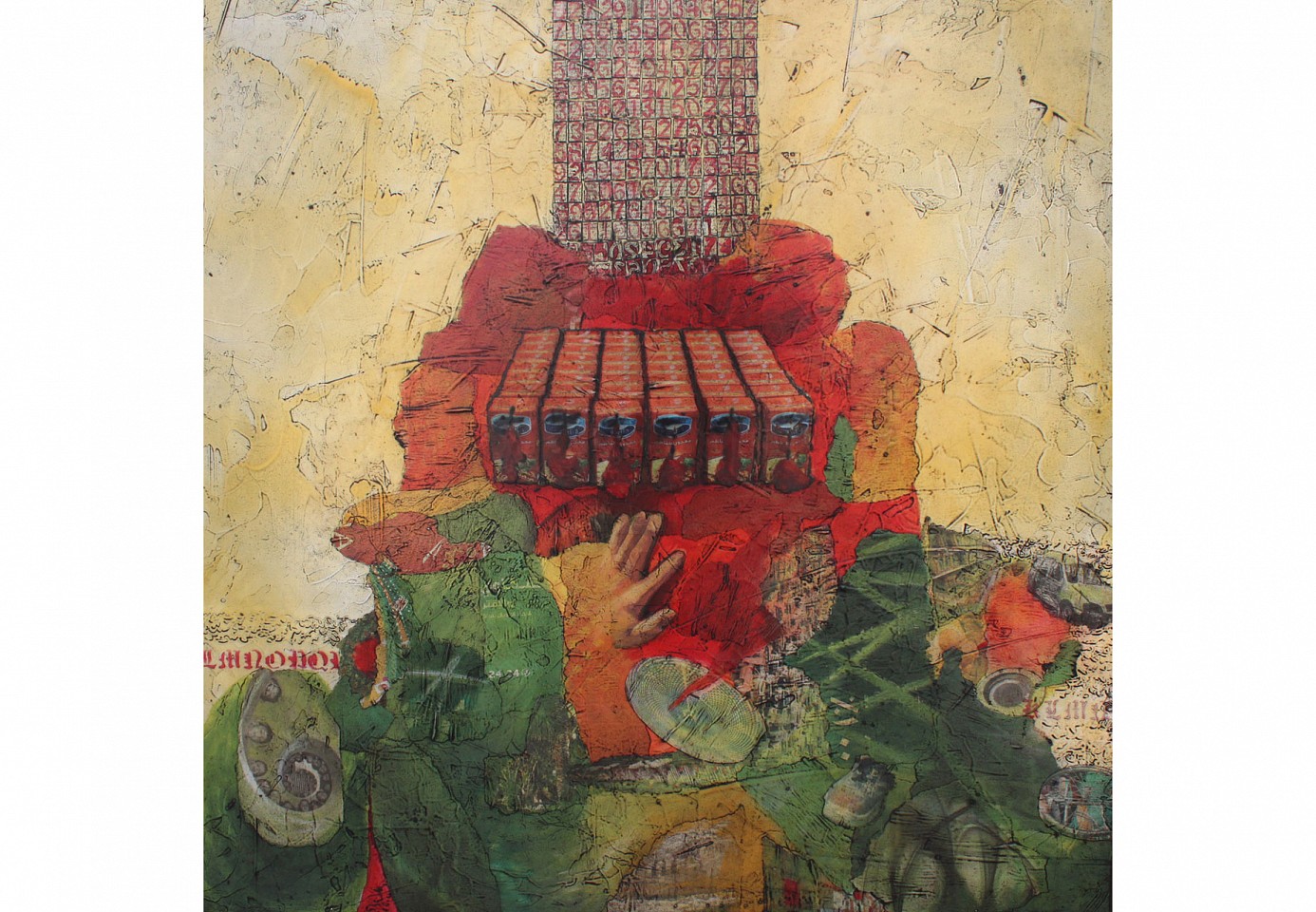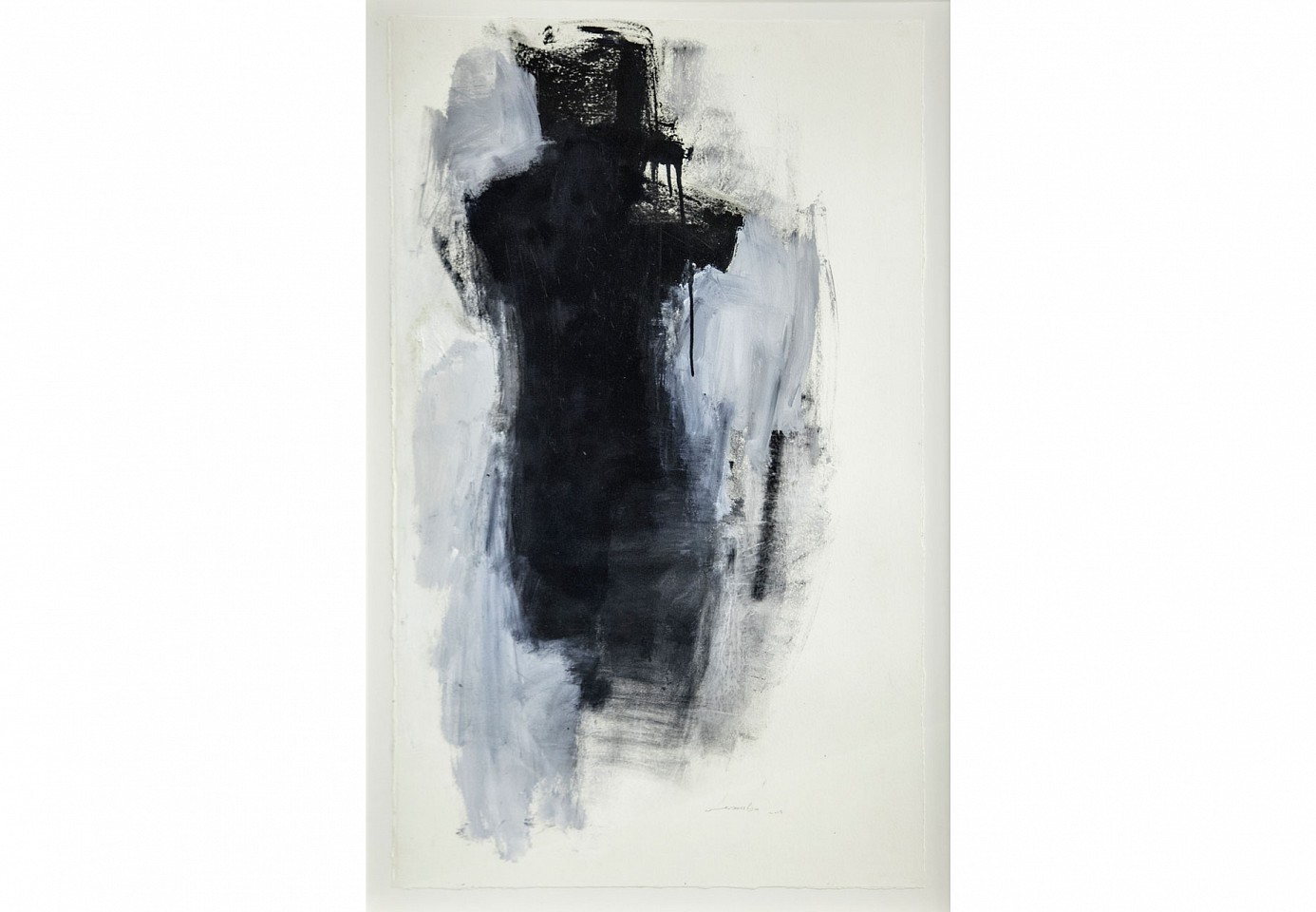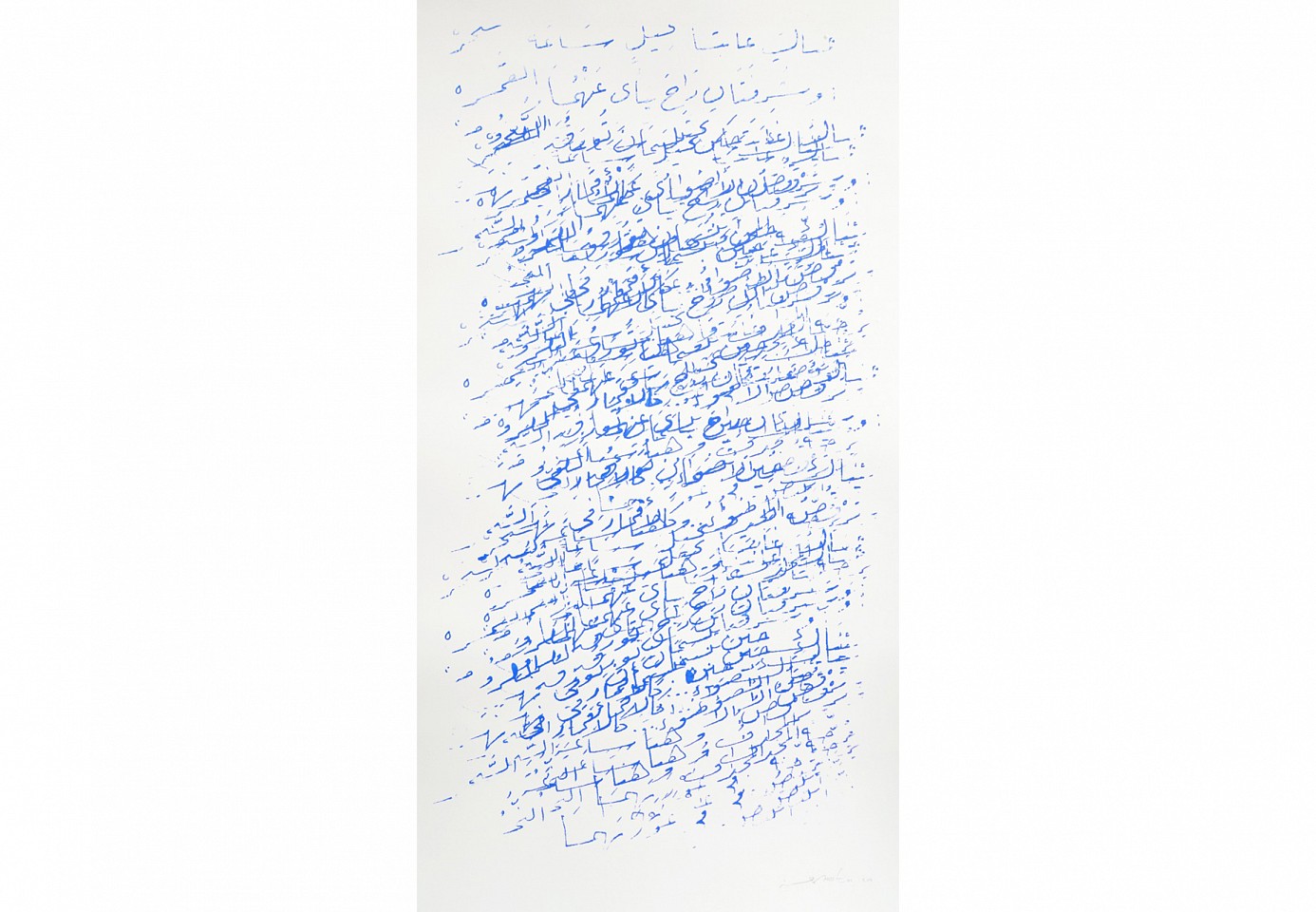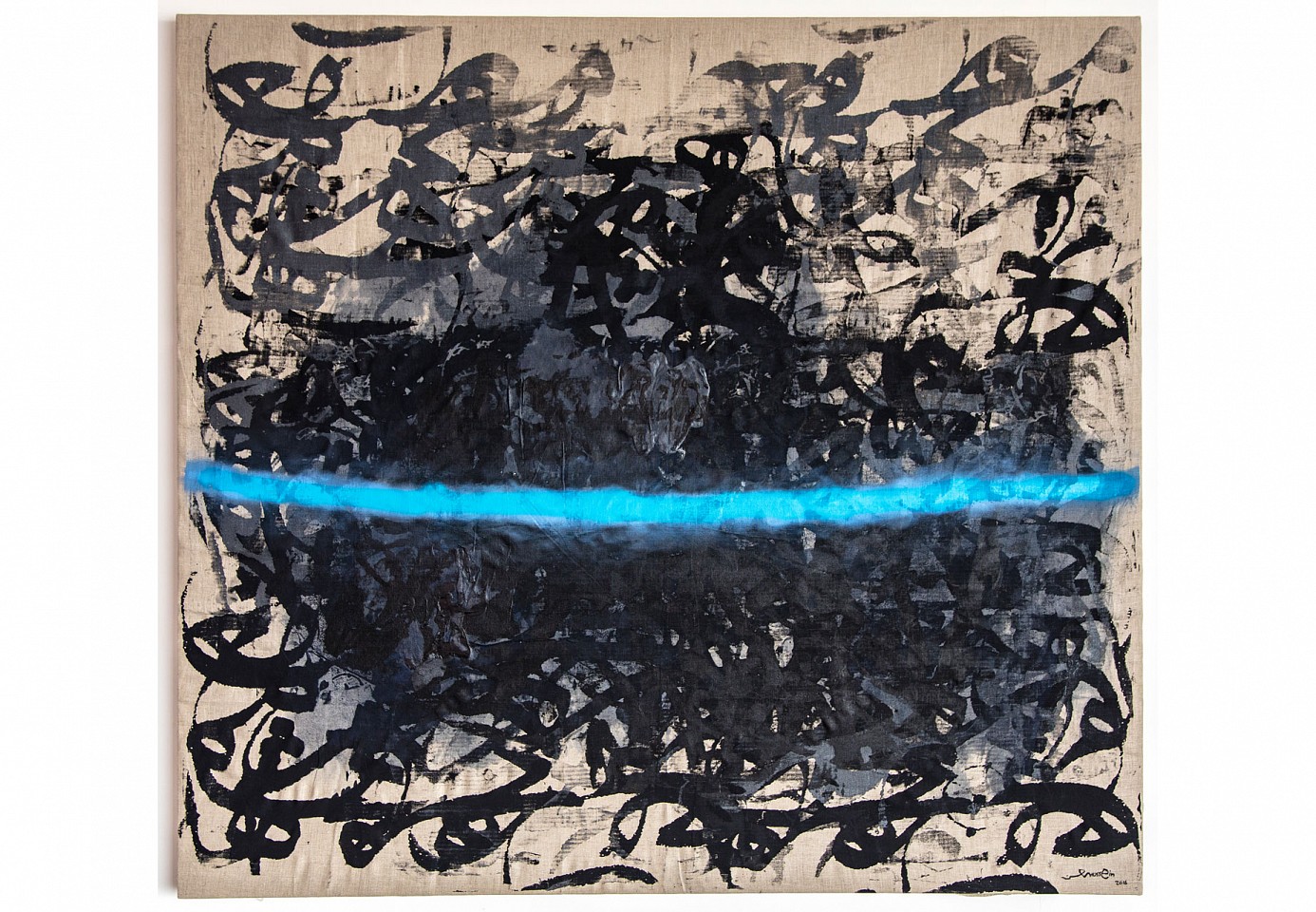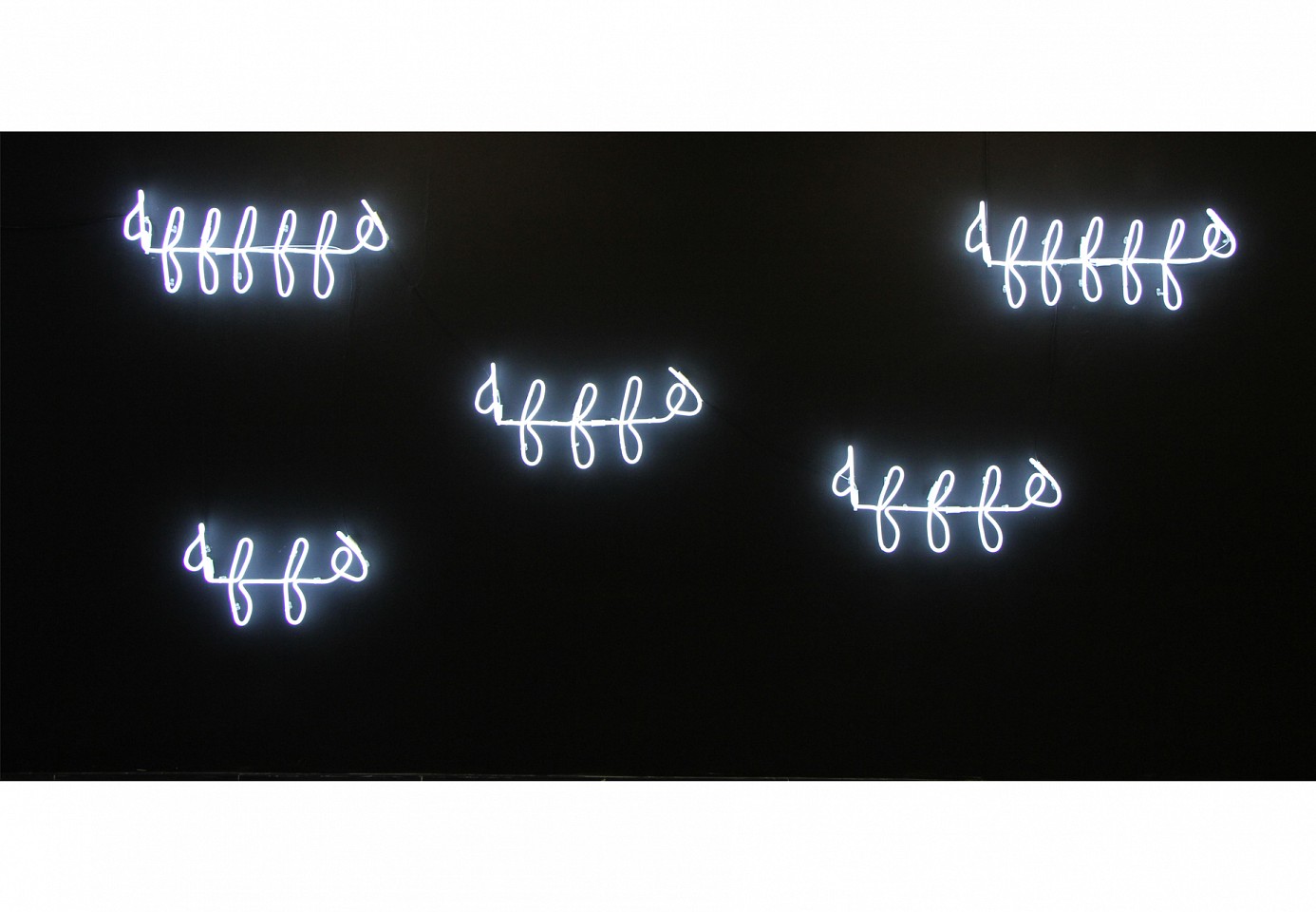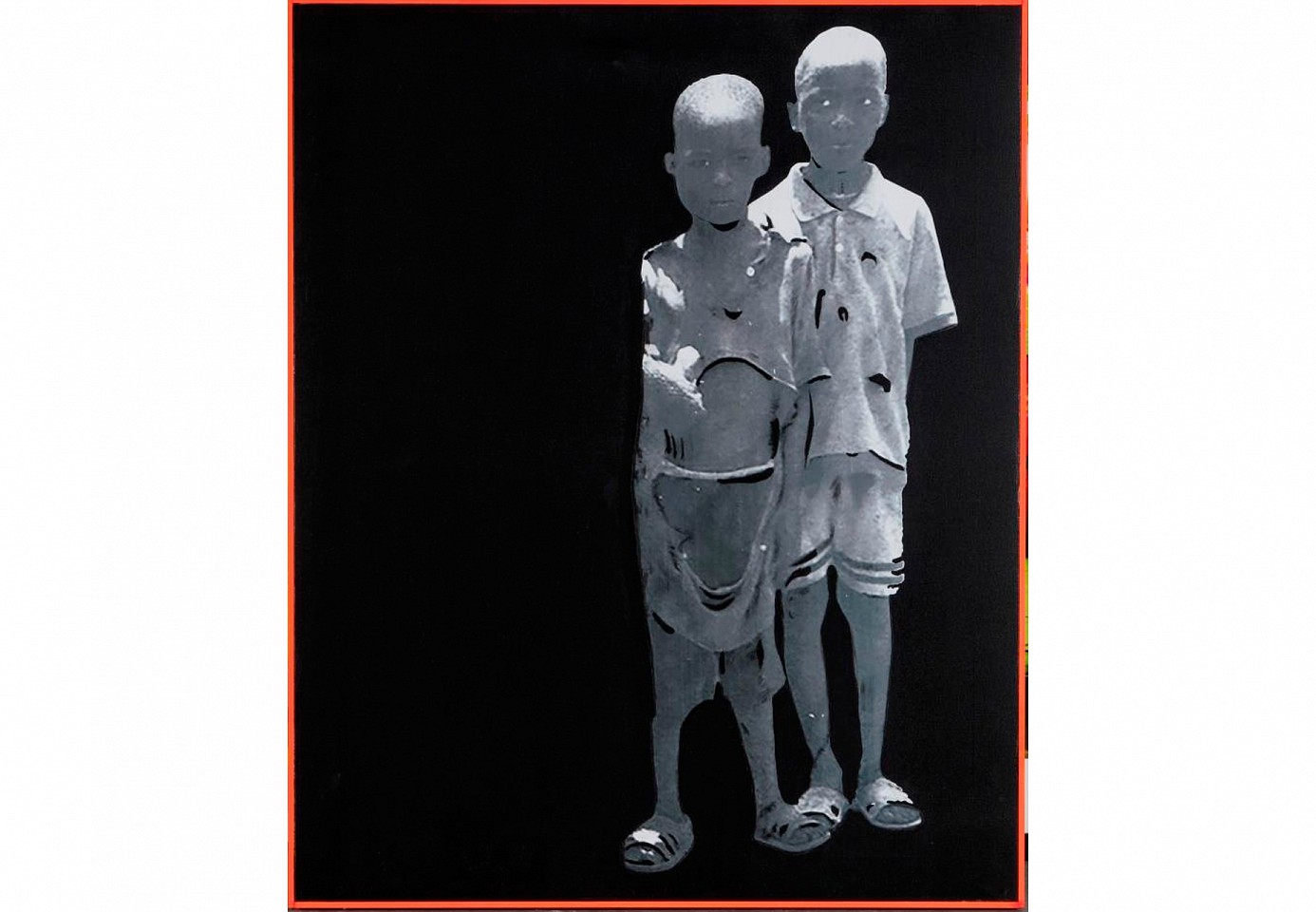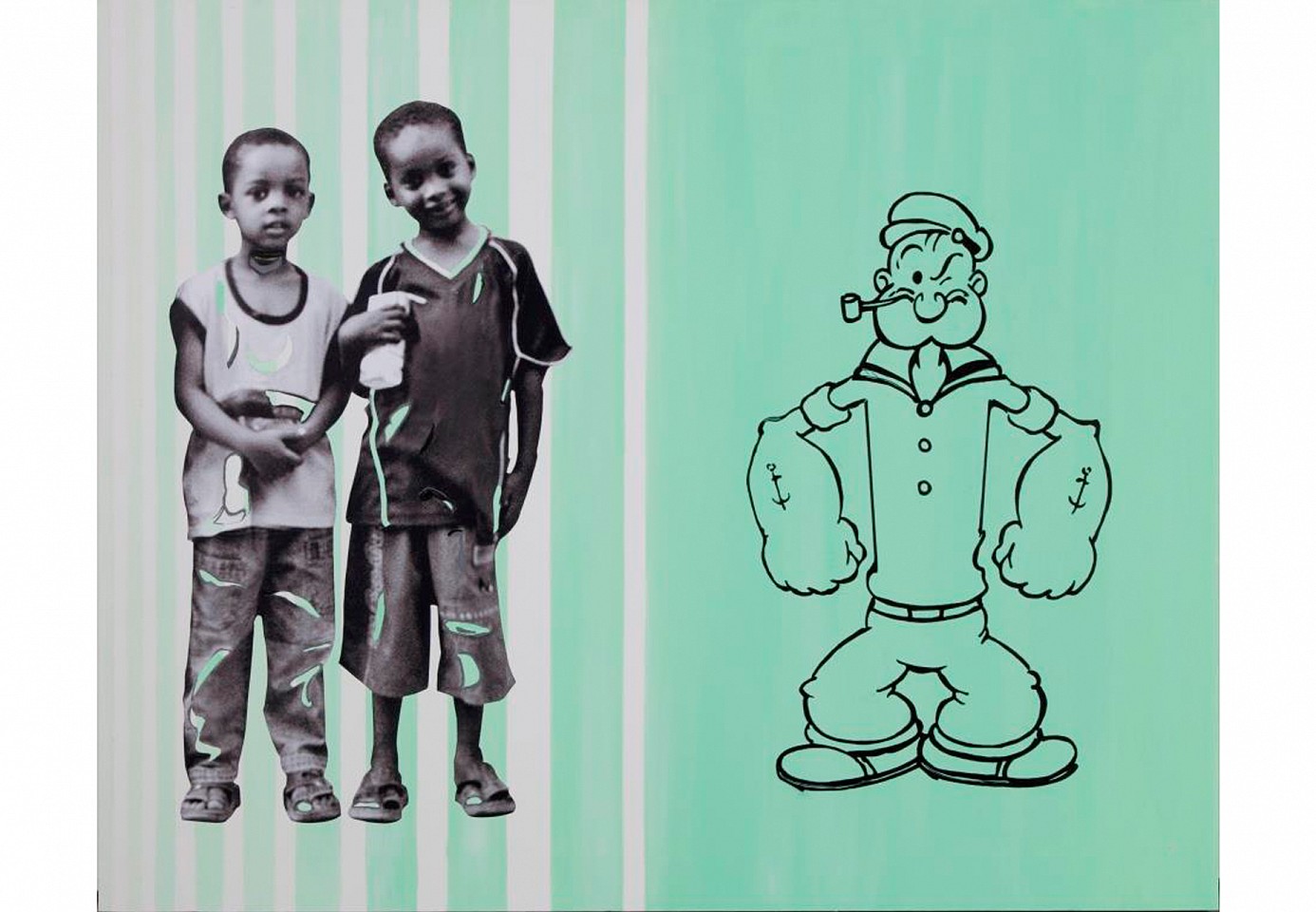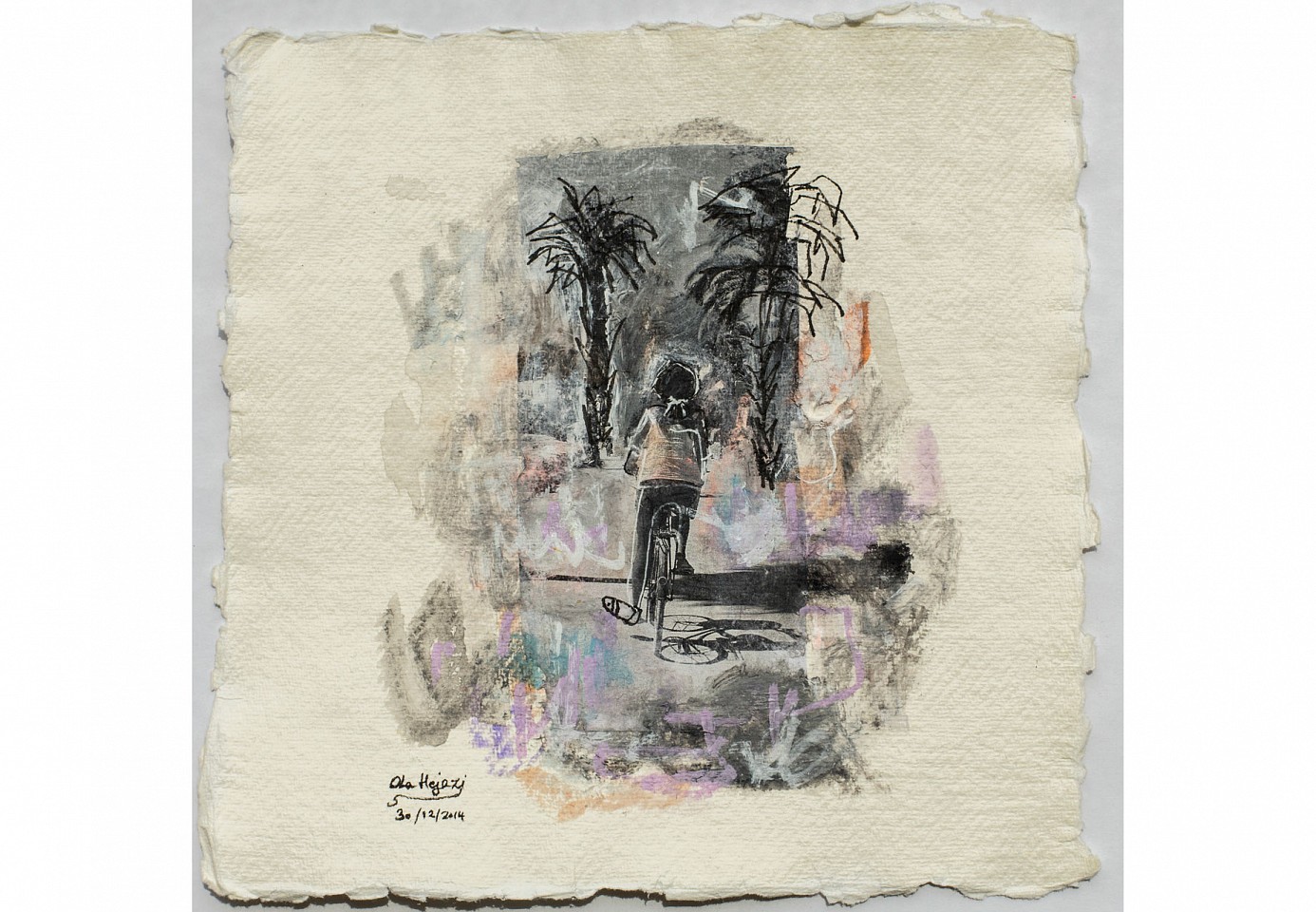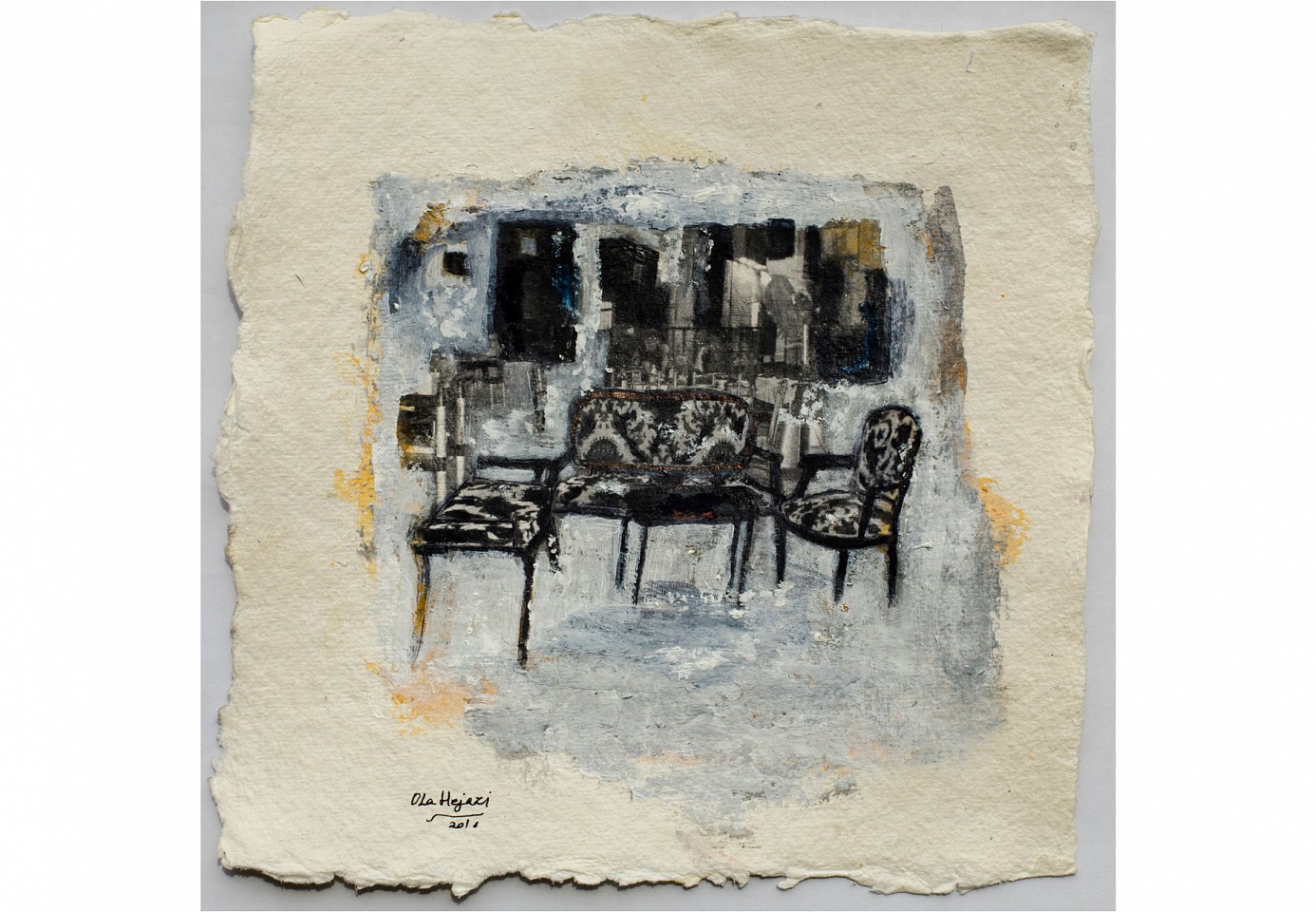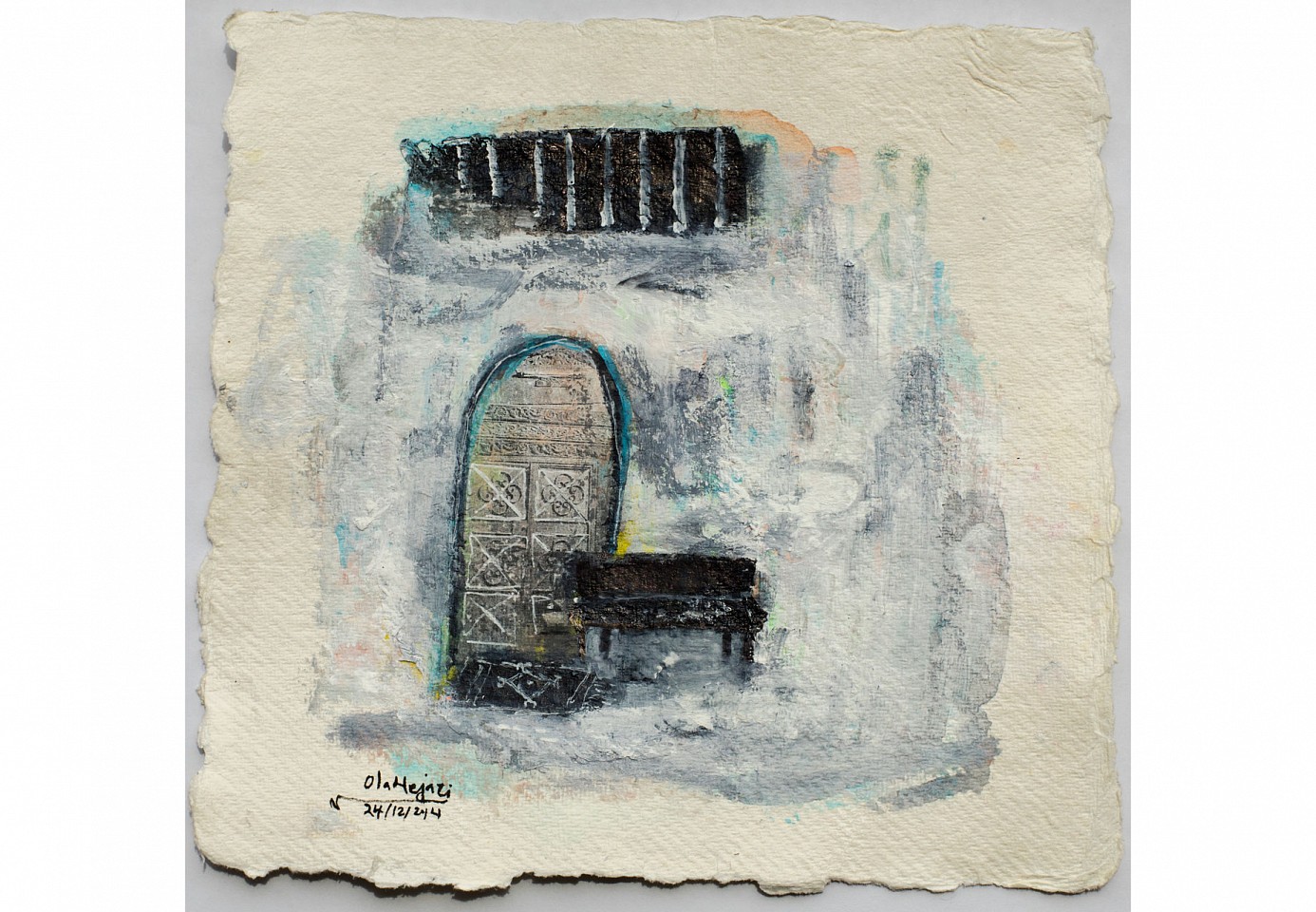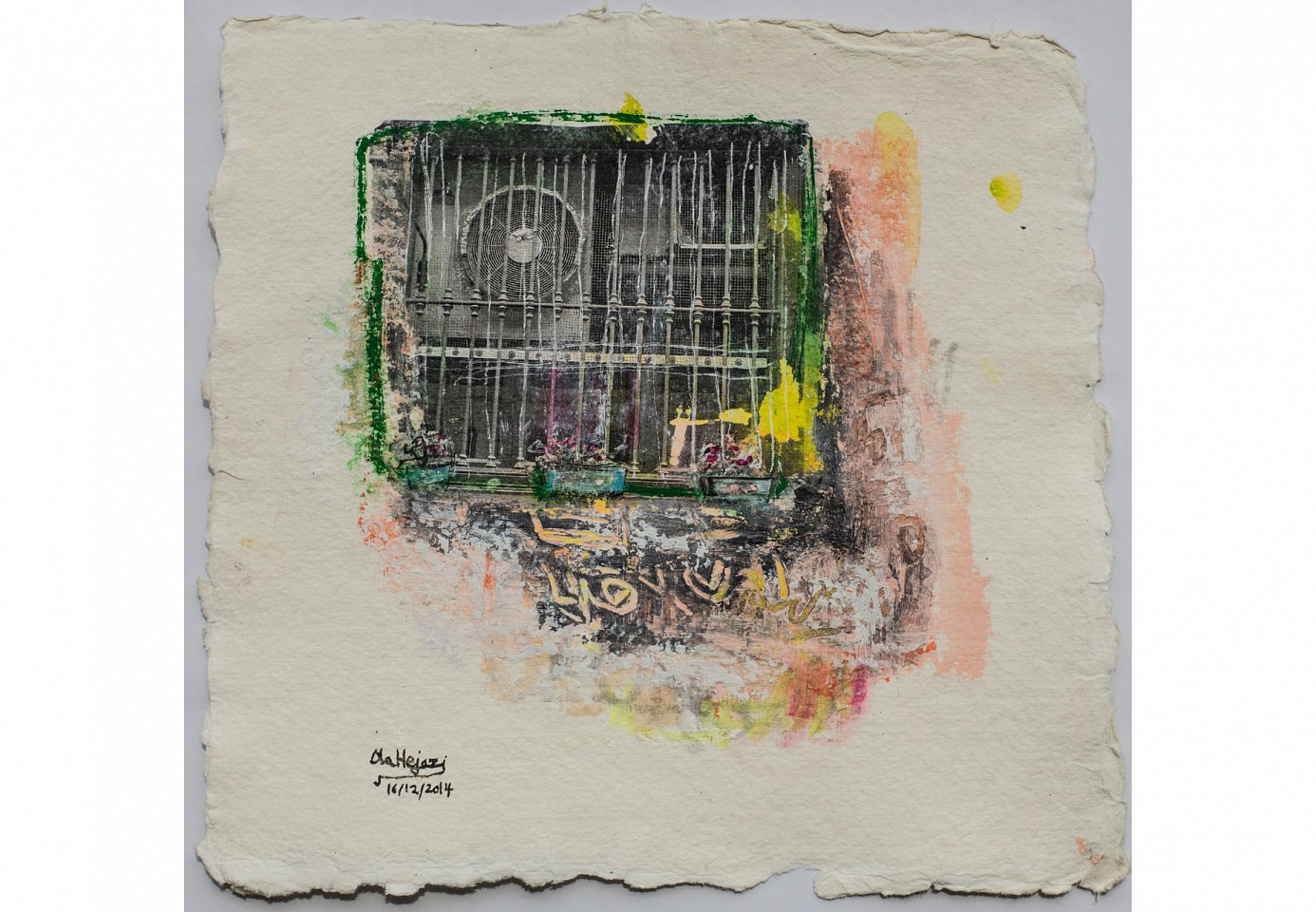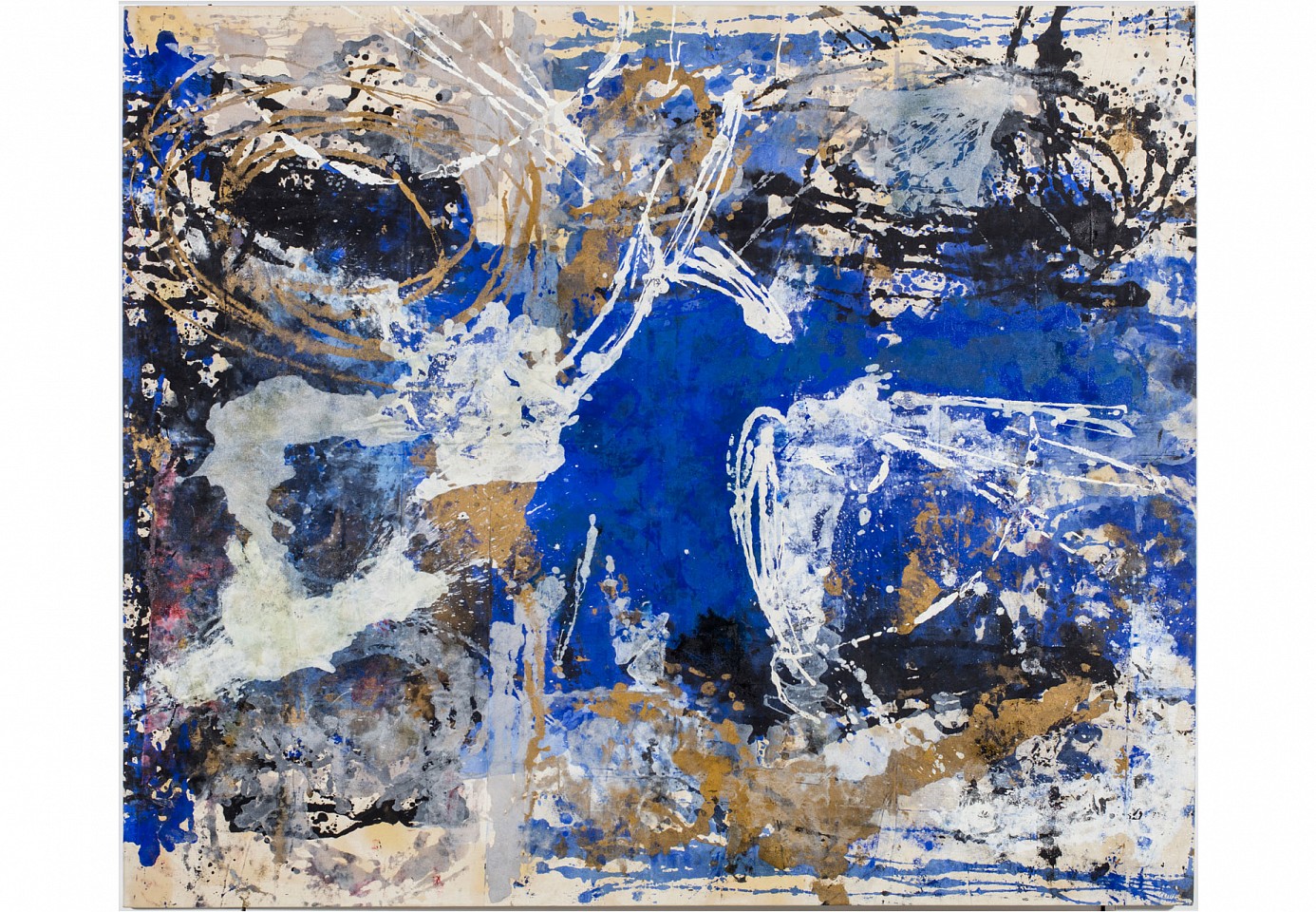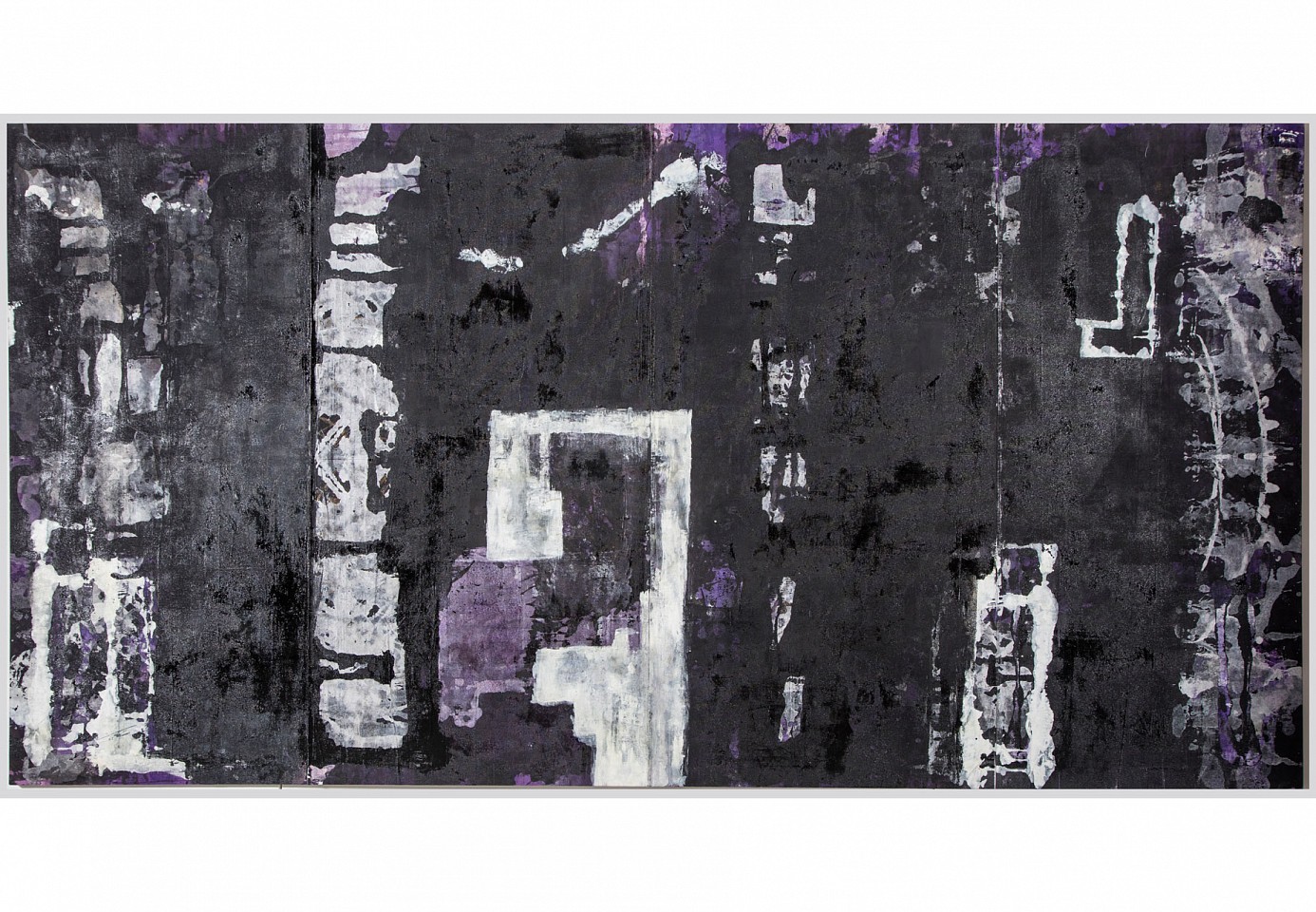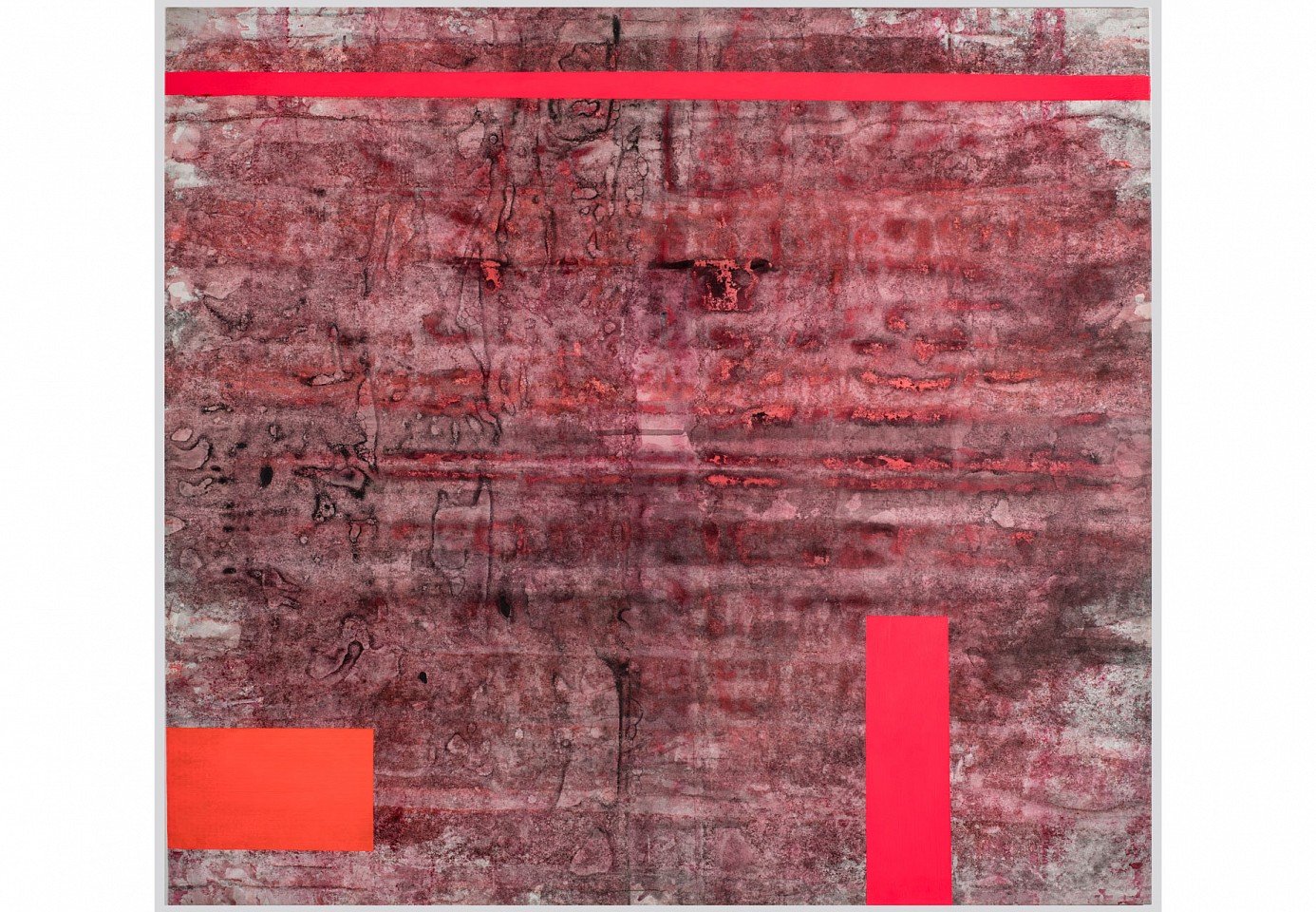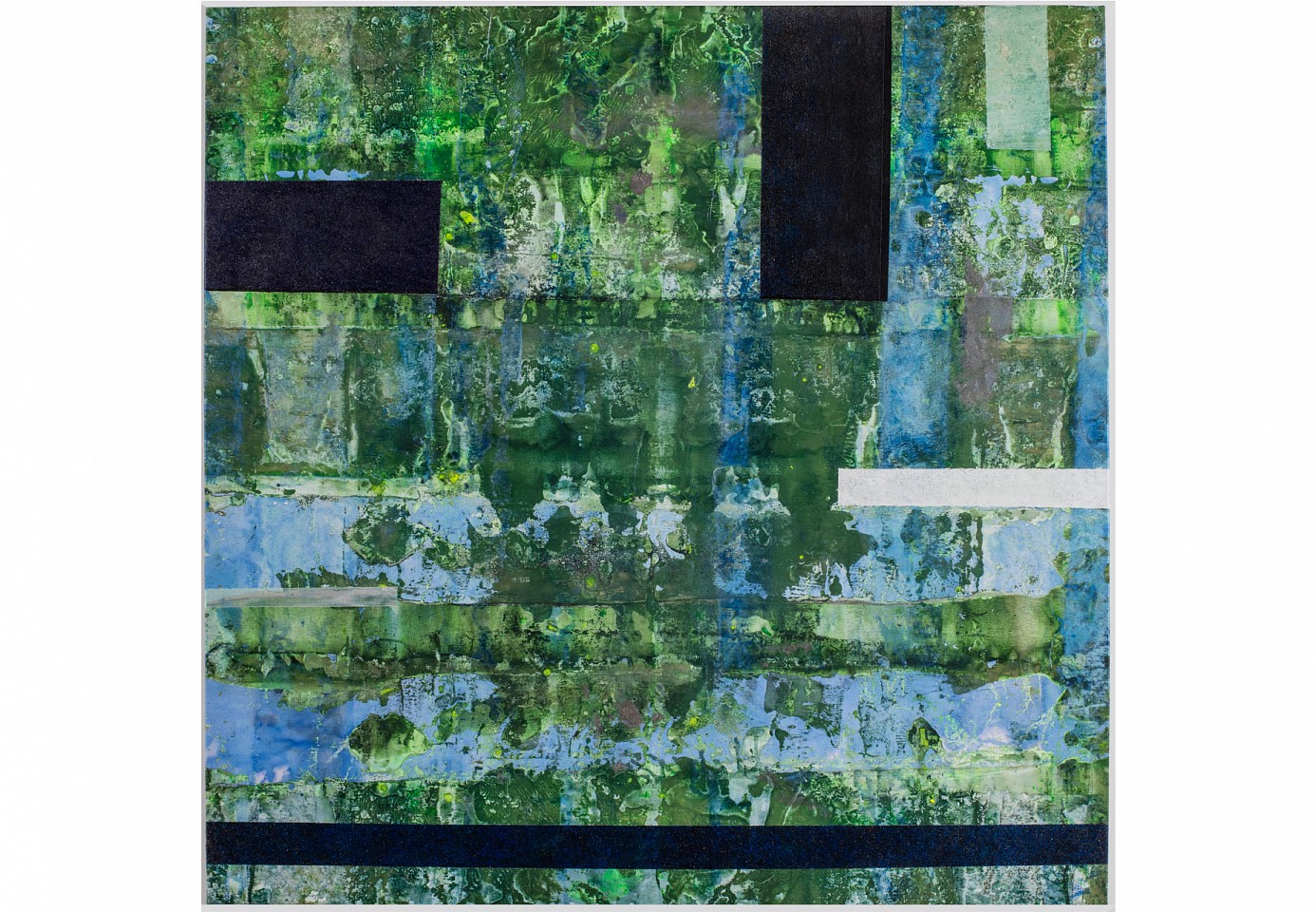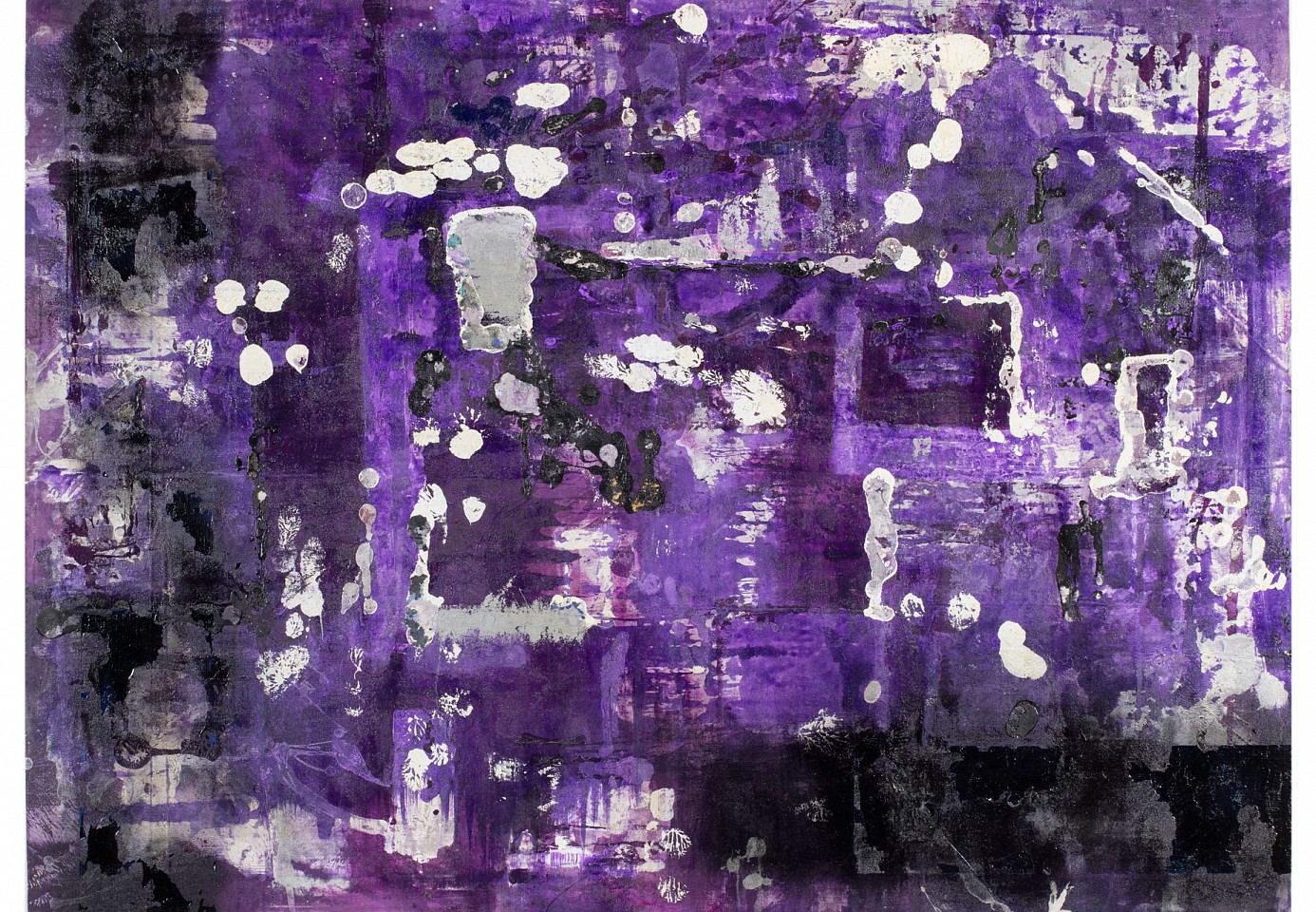Asma Bahmim
Athr 2, 2016
Gouache, hand painting, collage, gold leaf and silk-screened pigment on paper
21 x 21 cm
From The Road to Makka Series
ABM0002
Asma Bahmim
Al-Mahmal 2, 2016
Gouache, hand painting, and chmincke ink on paper
20 x 28 cm
From The Road to Makka Series
ABM0004
Asma Bahmim
Beauty and Community, 2016
Gouache, hand painting, collage gold leaf and acrylic ink on paper
23 x 31 cm
From Dreams Philosopher Series
ABM0007
Asma Bahmim
DéjÁ Senti, 2016
Gouache, hand painting and water color on paper
20 x 28 cm
From Déjà vu Series
ABM0009
Asma Bahmim
Return, 2016
Gouache, hand painting and water color on paper
21 x 30.5 cm
From Déjà vu Series
ABM0008
Asma Bahmim
Hijab, 2016
Gouache, hand painting water color and collage on paper
21 x 28 cm
From Déjà vu Series
ABM0010
Asma Bahmim
The Powerpuff Girls, 2016
Gouache, hand painting and water color on paper
21 x 28 cm
From Déjà vu Series
ABM0011
Asma Bahmim
Tree Art, 2016
Gouache, hand painting, collage gold leaf and acrylic ink on paper
30 x 25 cm
From Dreams Philosopher Series
ABM0013
Asma Bahmim
Untitled, 2016
Gouache, hand painting, collage gold leaf and acrylic ink on paper
30 x 21 cm
From Déjà vu Series
ABM0016
Asma Bahmim
Link, 2016
Gouache, hand painting, collage gold leaf and acrylic ink on paper
23 x 30 cm
From Dreams Philosopher Series
ABM0015
Asma Bahmim
Fold, 2016
Gouache, hand painting, collage, gold leaf and acrylic ink on paper
30 x 22.5 cm
From Dreams Philosopher Series
ABM0012
Abdulmohsen Farahat
Jeddah DNA (2), 2016
Print on Paper
41 x 29 cm
Edition of 30
AMF0001
Abdulmohsen Farahat
Al Madinah Al Munawarah DNA 4, 2016
Print on Paper
33 x 33 cm
Edition of 30
AMF0002
Abdulmohsen Farahat
Abha, Layers of Vision, 2016
Print on Paper
45 x 32 cm
Edition of 30; From Home, Serenity and Beauty
AMF0003
Ghada Al Hasan
Narrow Sky
Mixed Media
100 x 100 cm
GAH0001
Ghada Al Hasan
A Serious Atempt at Forgetting
Mixed Media
100 x 100 cm
GAH0002
Hussein Al Mohsen
Mysticism, 2016
Oil color, mixed media on Arch paper
180 x 150 cm
HAM0001
Hussein Al Mohsen
Untitled I, 2016
Silk Screen on Paper
110 x 60 cm
From the Rain Song Series
HAM0003
Hussein Al Mohsen
Untitled III, 2016
Mixed Media on Raw Canvas
178 x 161 cm
From the Rain Song Series
HAM0004
Majed Al Thubaity
Hhhhh, 2016
Neon Installation
MAT0001
Nada Halabi
Balad Boys I, 2016
Acrylic and Mixed Media
104 x 128 cm
From Dreams and Memories series
NH0001
Nada Halabi
Balad Boys and Popeye, 2016
Acrylic and Mixed Media
125 x 102 cm
From Dreams and Memories series
NH0002
Ola Hejazi
Untitled III, 2016
Image Transfer on Paint and Paper
22 x 22 cm
From Fragments Series
OH0003
Ola Hejazi
Untitled IV, 2016
Collage on Paint and Paper
22 x 22 cm
From Fragments Series
OH0004
Ola Hejazi
Untitled V, 2016
Collage on Paint and Paper
22 x 22 cm
From Fragments Series
OH0005
Ola Hejazi
Untitled VI, 2016
Collage on Paint and Paper
22 x 22 cm
From Fragments Series
OH0006
Ola Hejazi
Untitled VIII, 2016
Collage on Paint and Paper
22 x 22 cm
From Fragments Series
OH0008
Sultan Bin Fahad
Untitled I, 2016
Paint on Canvas
230.5 x 191.5 cm
SBF0002
Sultan Bin Fahad
Untitled II, 2016
Paint on Canvas
366 x 186.5 cm
SBF0003
Sultan Bin Fahad
Untitled III, 2016
Paint on Canvas
160 x 175.5 cm
SBF0004
Sultan Bin Fahad
Untitled IV, 2016
Paint on Canvas
143 x 143 cm
SBF0001
Sultan Bin Fahad
Untitled V, 2016
Paint on Canvas
190.5 x 138.5 cm
SBF0005
































تستلهم أسماء باهميم أعمالها الÙنيّة من المنمنمات الإسلامية، وقد كانت الÙنانة Øريصةعلى استكشا٠المواضيع الØالية للعالم المعاصر من خلال تخيلها لمضمونه وشكله. وتسعى الÙنانة إلى Ø¥Øياء ÙÙ† المنمنمات، والØÙاظ على جاذبيته التقنية والجمالية. والشخصيات المصورة والمشاهد المعقدة المتعددة الطبقات ÙÙŠ لوØاتها لا تثير Ùقط تساؤلات Øول المÙاهيم المÙعبّر عنها، بل ØªØ·Ø±Ø Ø£Ø³Ø¦Ù„Ø© عن طبيعة الÙÙ† وتصوّر Ùهمها السابق وممارستها.
Inspired by Islamic miniatures, the artist was keen to explore current themes of today’s world byway of reimagining its content and form. The artist endeavors to revive the art of miniature paintings, preserving its technique and aesthetical allure. The depicted figures and multi-layered complex scenes not only raise questions on the notions expressed, but about the nature of art and the perception of its former understanding and practice.
الخطوط والألوان عنصران بارزان ÙÙŠ لوØات الدكتور عبدالمØسن ÙرØات، واستخدامه لهما، ليرمز ÙÙŠ تصوير الأشكال والأماكن التأكيد على الصور الذهنية المألوÙØ© للمناظر الطبيعية والثقاÙية، والدينية إلى دقة القضايا الأساسية ÙهدÙÙ‡ عدم المواجهة، ولكن تØقيق عدد لا ÙŠÙØصى من التÙسيرات البصرية والإيØائية.
Lines and color are prominent elements in Dr. Abdelmohsen’s paintings. His use of color and lines to depict forms and figures re-emphasize familiar mental images of cultural, natural and religious landscapes. The subtlety of the underlying issues addressed is intentional, as his aim is not to confront, but to realize a myriad of visual and conceptual interpretations.
المØليّة ليست Ùكرة مبسطة، Ùبناء الهوية هو تدÙÙ‚ معقد... ونظراً لسهولة الØصول على المعلومات، بات من الصعب ÙÙŠ هذه الأيام ÙˆÙÙŠ هذا العصر الÙصل ما بين الÙرد المØليّ وما بين المواطن العالمي الذي بات شاهداً على تقلبات العالم من Øوله.
Locality is not a simplistic idea, the construction of identity is a complex influx. Due to the accessibility of information, it is getting harder at this day and age to separate one’s locality from one’s being a global citizen, witnessing the ups and downs of the world.
اللون هو العنصر الÙلسÙÙŠ القديم والنشط ÙÙŠ لوØات Øسين المØسن الÙنية. واستخدامه للون هو Ù…Øاولة للكش٠عن الØقائق المدÙونة داخل المÙشاهد، Ùأعماله تسعى لتقديم رسالة، ومن بينها سعيه للتأثير على الاستجابات الÙسيولوجية غير المكتشÙØ©. بالنسبة للÙنان، أعماله الÙنية هي الرØلات البصرية التي تÙثير نوعا من الØوار "المÙتوØ"Ø› والذي يمكن أن يتØقق Ùقط عندما يتمّ تØÙيزنا على التواصل بØرية ÙÙŠ أنقى أشكالنا.
Color is an ancient and active philosophical element that is heavily explored in Hussein’s artistic practice. The use of color is the artist’s attempt to unearth truths buried within the viewer. His works are intended to deliver a message, one in which he strives to affect raw and uninhibited physiological and emotional responses. For the artist, his works are visual journeys that facilitate a type of “open” dialogue: a conversation that can only be realized when we are stimulated to communicate freely in our purest forms.
ÙŠØاول ماجد الثبيتي تسليط الضوء على العبارات المكتوبة والمنطوقة باللغة العربية من خلال وسائل الاتصال الØديثة، Ùمثلاً "ههه" هي اسم الصوت الذي ÙŠÙخرجه الإنسان عند الضØك، وهو –هذا الØرÙ- يتكرر ÙÙŠ جميع جزئيات الكلمة، بداية ووسطا ونهاية...وهو من خلال عمله هذا ÙŠØ·Ø±Ø ØªØ³Ø§Ø¤Ù„Ø§ عن مدى ضرورة ÙˆÙعالية هذه الكلمات ÙÙŠ التعبير عن تعقيدات عالمنا المعاصر.
The work of Majed explores the shape and function of a written phrase used in today’s contemporary Arabic language. Introduced by modern means of communication, the word is the phonetic sound one makes when laughing. The Arabic letter “ha” is repeated throughout the word, and as such, its form changes depending on its position in the beginning, middle and end of the word. His work attempts to both shed light on the induction of written and spoken phrases into the language, and to question the necessity and effectiveness of these words in expressing the complexities of our contemporary world.
تØاول ندى الØلبي من خلال عملها الÙني تجسيد الذاكريات الجماعية للعالم الÙاضل، مجزأة وملاصقة Ù„Øقائق واقعها. عبر هذه الأعمال الÙنيّة تÙØ®ÙÙŠ الÙنانة زمن البراءة، ÙÙŠ Ù…Øاولة لإيجاد السعادة، عاكسة Ø£Øلام الكثر الراغبين تØقيق Øياة Ø£Ùضل.
Nada’s work attempts to embody the collective memories of a utopian world, fragmented and juxtaposed with the truths of her reality. The works realize the loss of innocence, and the pursuit of happiness; reflecting the dreams of many for a better life.
علا Øجازي هي رسامة توّق٠عمرها الاÙتراضي بسبب الانتقال المÙاجىء، والسÙر المستمر. ÙÙŠ بعض الأØيان، أجبرت علا على ترك مقتنياتها الشخصية التي تØمل قيمة عاطÙية كبيرة، وتذكرها بÙترة نشأتها. ÙÙŠ Ù…Øاولة لإعادة بناء هذه اللØظات، وتØاول علا توثيق الأشياء واللØظات التي تستØضر شعور الذكريات الماضية. تَجمّع الذكريات المتناثرة التي من خلالها تتمكن من وص٠وتصور اللØظة التي تنقلها إلى الوقت الÙائت من ماضيها
Ola Hejazi is a painter whose lifespan has been interrupted by frequent abrupt relocation, and constant travel. At times, she was forced to leave behind personal items that hold sentimental value, and embody memories of her upbringing. In an attempt to reconstruct these moments, Ola attempts to document the objects and moments in the present that trigger these fleeting memories of the past. The assemblage of fragmented memories is realized by depicting the instant in which an object is able to transport her to a lost time in her past.
لوØات سلطان بن Ùهد الكبيرة غالباً ما تغطيها طبقات سميكة من الطلاء، يتخللها خطوط جريئة من الألوان. وهو يعتمد هذا المقاس من اللوØات ليÙرض وجودها على المشاهد، ليثير ردود Ùعل عاطÙية، وليØقيق Ù„Øظة من الألÙØ© والتناغم. ÙŠØاول من خلالها تسليط الضوء على Øالتنا العاطÙية، وكتذكير Ù„Ùغرائزنا البشرية الÙطرية.
Sultan bin Fahad’s large paintings are often covered completely with thick strokes of paint, interrupted with bold lines of color. Its scale is meant to impose its presence on the viewer, provoking an emotional response, and realizing a moment of intimacy and vulnerability. His works attempt to shed light on our emotional state, and pose as reminders of our natural human instincts.
الأØلام والذكريات
الأمس يغدو Ø°Ùكرى، Ùˆ الغد يبقى ØÙلماً.
جبران خليل جبران.
الØلم والذكريات Ø£Øدهما يستدعي الآخر.. كلاهما يتنوع بتنوع Øياتنا. اليوم نمر بتجارب مجموعة من الÙنانين لنبØر معهم ÙÙŠ Ø£Øلامهم وذكرياتهم.
Dreams And Memories
“Yesterday Is But Today’s Memory. Tomorrow Is Today’s Dream”
KahalilGibran
Our dreams and memories call upon each other; they rely on our experiences in the lives we’ve led. Today, we embark upon the visual narrative of artists as they explore their dream.

